#integrated command and control center
Explore tagged Tumblr posts
Text
25 Years of Exploring the Universe with NASA's Chandra Xray Observatory

Illustration of the Chandra telescope in orbit around Earth. Credit: NASA/CXC & J. Vaughan
On July 23, 1999, the space shuttle Columbia launched into orbit carrying NASA’s Chandra X-ray Observatory. August 26 marked 25 years since Chandra released its first images.
These were the first of more than 25,000 observations Chandra has taken. This year, as NASA celebrates the 25th anniversary of this telescope and the incredible data it has provided, we’re taking a peek at some of its most memorable moments.
About the Spacecraft
The Chandra telescope system uses four specialized mirrors to observe X-ray emissions across the universe. X-rays that strike a “regular” mirror head on will be absorbed, so Chandra’s mirrors are shaped like barrels and precisely constructed. The rest of the spacecraft system provides the support structure and environment necessary for the telescope and the science instruments to work as an observatory. To provide motion to the observatory, Chandra has two different sets of thrusters. To control the temperatures of critical components, Chandra's thermal control system consists of a cooling radiator, insulators, heaters, and thermostats. Chandra's electrical power comes from its solar arrays.
Learn more about the spacecraft's components that were developed and tested at NASA’s Marshall Space Flight Center in Huntsville, Alabama. Fun fact: If the state of Colorado were as smooth as the surface of the Chandra X-ray Observatory mirrors, Pike's Peak would be less than an inch tall.

Engineers in the X-ray Calibration Facility at NASA’s Marshall Space Flight Center in Huntsville, Alabama, integrating the Chandra X-ray Observatory’s High-Resolution Camera with the mirror assembly, in this photo taken March 16, 1997. Credit: NASA
Launch
When space shuttle Columbia launched on July 23, 1999, Chandra was the heaviest and largest payload ever launched by the shuttle. Under the command of Col. Eileen Collins, Columbia lifted off the launch pad at NASA’s Kennedy Space Center in Florida. Chandra was deployed on the mission’s first day.

Reflected in the waters, space shuttle Columbia rockets into the night sky from Launch Pad 39-B on mission STS-93 from Kennedy Space Center. Credit: NASA
First Light Images
Just 34 days after launch, extraordinary first images from our Chandra X-ray Observatory were released. The image of supernova remnant Cassiopeia A traces the aftermath of a gigantic stellar explosion in such captivating detail that scientists can see evidence of what is likely the neutron star.
“We see the collision of the debris from the exploded star with the matter around it, we see shock waves rushing into interstellar space at millions of miles per hour,” said Harvey Tananbaum, founding Director of the Chandra X-ray Center at the Smithsonian Astrophysical Observatory.

Cassiopeia A is the remnant of a star that exploded about 300 years ago. The X-ray image shows an expanding shell of hot gas produced by the explosion colored in bright orange and yellows. Credit: NASA/CXC/SAO
A New Look at the Universe
NASA released 25 never-before-seen views to celebrate the telescopes 25th anniversary. This collection contains different types of objects in space and includes a new look at Cassiopeia A. Here the supernova remnant is seen with a quarter-century worth of Chandra observations (blue) plus recent views from NASA’s James Webb Space Telescope (grey and gold).

This image features deep data of the Cassiopeia A supernova, an expanding ball of matter and energy ejected from an exploding star in blues, greys and golds. The Cassiopeia A supernova remnant has been observed for over 2 million seconds since the start of Chandra’s mission in 1999 and has also recently been viewed by the James Webb Space Telescope. Credit: NASA/CXC/SAO
Can You Hear Me Now?
In 2020, experts at the Chandra X-ray Center/Smithsonian Astrophysical Observatory (SAO) and SYSTEM Sounds began the first ongoing, sustained effort at NASA to “sonify” (turn into sound) astronomical data. Data from NASA observatories such as Chandra, the Hubble Space Telescope, and the James Webb Space Telescope, has been translated into frequencies that can be heard by the human ear.
SAO Research shows that sonifications help many types of learners – especially those who are low-vision or blind -- engage with and enjoy astronomical data more.
Click to watch the “Listen to the Universe” documentary on NASA+ that explores our sonification work: Listen to the Universe | NASA+

An image of the striking croissant-shaped planetary nebula called the Cat’s Eye, with data from the Chandra X-ray Observatory and Hubble Space Telescope. NASA’s Data sonification from Chandra, Hubble and/or Webb telecopes allows us to hear data of cosmic objects. Credit: NASA/CXO/SAO
Celebrate With Us!
Dedicated teams of engineers, designers, test technicians, and analysts at Marshall Space Flight Center in Huntsville, Alabama, are celebrating with partners at the Chandra X-ray Center and elsewhere outside and across the agency for the 25th anniversary of the Chandra X-ray Observatory. Their hard work keeps the spacecraft flying, enabling Chandra’s ongoing studies of black holes, supernovae, dark matter, and more.
Chandra will continue its mission to deepen our understanding of the origin and evolution of the cosmos, helping all of us explore the Universe.

The Chandra Xray Observatory, the longest cargo ever carried to space aboard the space shuttle, is shown in Columbia’s payload bay. This photo of the payload bay with its doors open was taken just before Chandra was tilted upward for release and deployed on July 23, 1999. Credit: NASA
Make sure to follow us on Tumblr for your regular dose of space: http://nasa.tumblr.com
2K notes
·
View notes
Text
⠀⠀⠀⠀⠀⠀⠀Lucifer's Jealousy.

Unlike Alastor's imposing confidence, Lucifer exhibits a palpable insecurity reflected in his behavior. Despite being the King of Hell, whose aura of power and authority often commands near-reverential respect, his personal doubts emerge clearly in moments of jealousy. When Lucifer perceives a threat, whether real or imagined, to his relationship with you, his demeanor subtly but noticeably changes. His face, which normally radiates an uncomfortable confidence, becomes darker and more reserved. He might try to hide his concerns behind a façade of indifference, but it is in these moments of vulnerability that his true fear of not being the partner you expect becomes apparent. His actions and words reveal the internal struggle he faces, and despite his effort to maintain control, his insecurity becomes visible in small gestures and changes in his behavior.
Instead of exploding in rage or confronting the situation directly, Lucifer tends to withdraw into himself. His prolonged silences and inclination to subtly distance himself are indicative of internal turmoil. The distance he creates between you is not a punishment but a reflection of his emotional unrest. His gaze becomes introspective and melancholic, observing every detail with a meticulous scrutiny that he hadn’t shown before.
He often surprises you with exaggerated gestures of affection, as if trying to reaffirm his importance in your life. He arranges elegant dinners with almost excessive perfection or surprises you with small gifts designed to remind you of how much he values you. However, these acts are not merely to please you; they are a manifestation of his deep desire to ensure that you continue to see him as valuable and worthy of your love.
When he feels particularly jealous, his behavior may change, becoming more attentive to your needs and showing excessive vulnerability. His concern is constant, and he frequently seeks your approval through subtle gestures and details that demonstrate his longing to be the center of your affection. Although he doesn’t always express his fears directly, his conduct is imbued with a silent need for reassurance and security.
Through these moments, Lucifer reveals the depth of his love and how his insecurities, though often hidden for fear of bothering you, are an integral part of his being. His way of handling jealousy is introspective and laden with a sensitivity that highlights a sincere love and a constant need for your reaffirmation.

#hazbin hotel#hazbin hotel x reader#hazbin hotel lucifer#lucifer morningstar#lucifer x reader#lucifer morningstar x reader
148 notes
·
View notes
Text
Apollo Program: Lunar Module (LM) production and names

The Grumman Aerospace Corporation was awarded the contract on November 7, 1962. Originally designated Lunar Excursion Module (LEM), NASA ordered 25 lunar modules (10 test articles and 15 production models) for testing and landing on the moon. This was to go with the 15 Saturn Vs and Apollo CSMs. They were assembled in Grumman's factory in Bethpage, New York.
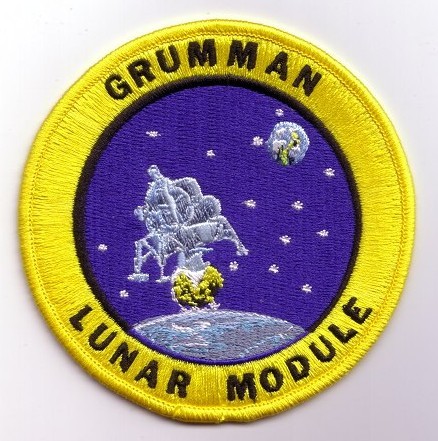

"There were initially four major subcontractors: Bell Aerosystems (ascent engine), Hamilton Standard (environmental control systems), Marquardt (reaction control system) and Rocketdyne (descent engine).
The Primary Guidance, Navigation and Control System (PGNCS) was developed by the MIT Instrumentation Laboratory; the Apollo Guidance Computer was manufactured by Raytheon (a similar guidance system was used in the command module). A backup navigation tool, the Abort Guidance System (AGS), was developed by TRW."
-Information from Wikipedia: link
After the Gemini 3 spacecraft was dubbed Molly Brown by Gus Grissom, NASA forbade naming spacecraft. For Apollo 9, this changed due to mission controllers in Houston needing a way to differentiate between the two spacecraft.
Between 1969 and 1972, Grumman produced a series of insignias for their Lunar Modules which were distributed in limited quantities to their employees in the form of decals and prints.
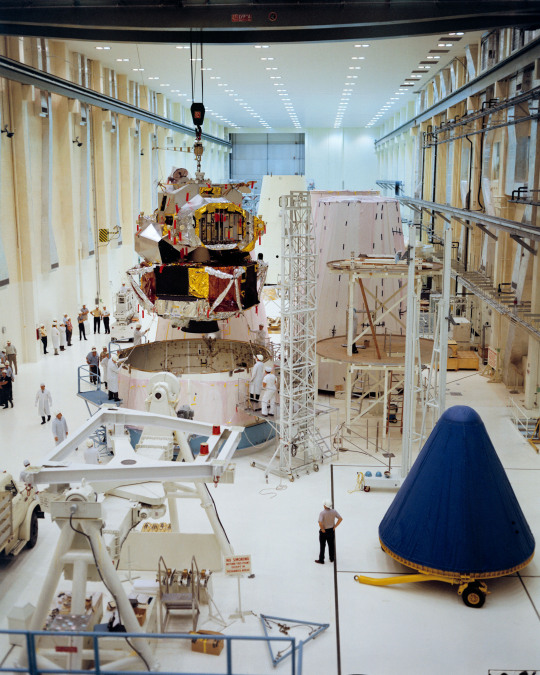
Apollo 5 (LM-1): none

Apollo 3 (and later 2) (LM-2): Never used, intended for a mission similar to Apollo 5. The success of LM-1 led to the cancellation.


Apollo 9 (LM-3): Spider


Apollo 10 (LM-4): Snoopy. The LM ascent stage in heliocentric orbit and is the only known one to have survived intact


Apollo 11 (LM-5): Eagle (originally named haystack)


Apollo 12 (LM-6): Intrepid


Apollo 13 (LM-7): Aquarius
Humorously, Grumman sent North American (the manufacturer of the Apollo Command and Service Module) a tow bill sometime after the crew returned. North American retorted back saying they've never sent them a tow bill for the previous missions.


Apollo 14 (LM-8): Antares.

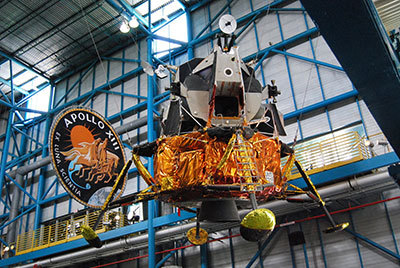
Apollo 15 (originally) (LM-9): never used, on display the Kennedy Space Center.
Intended for Apollo 15 and was the last H-type mission. When Apollo 18 was cancelled, it was decided to make Apollo 15 the first J-type mission.


Apollo 15 (LM-10): Falcon, originally intended for Apollo 16. First of the extended stay series.


Apollo 16 (LM-11): Orion, originally intended for Apollo 17


Apollo 17 (LM-12): Challenger, originally intended for Apollo 18.
Note: this name was reused for the second operational Space Shuttle Orbiter. After the Challenger Disaster, NASA officially retired the name.


Apollo 18 (LM-13): never used, originally intended for 19. It was partially completed when Apollo 18 and 19 were cancelled. Later restored by Grumman workers and is on display at the Cradle of Aviation History and Education Center.
Apollo 19 (LM-14): never used, originally intended for Apollo 20. It was partially completed when Apollo 18 and 19 were cancelled. What was completed, was later scrapped.

Apollo 20 (LM-15): never used, partially completed, scrapped. When Apollo 20 was cancelled, it was intended for modification into the Apollo Telescope Mount. Later the Telescope Mount was integrated into Skylab and this dedicated mission was cancelled.
source, source, source, source, source
NASA ID: MSFC-69-MS-G-1300-27, S67-50927, AS09-21-3183, AS10-34-5087, AS11-40-5946, AS12-46-6726, AS13-59-8566, AS14-66-9306, AS15-88-11866, AS16-113-18339, AS17-140-21370
#Lunar Module#Apollo Program#Apollo 5#LM-1#LM-2#Apollo 9#LM-3#Apollo 10#LM-4#Apollo 11#LM-5#Apollo 12#LM-6#Apollo 13#LM-7#Apollo 14#LM-8#LM-9#Apollo 15#LM-10#Apollo 16#LM-11#Apollo 17#LM-12#Apollo 18#LM-13#Apollo 19#LM-14#Apollo 20#LM-15
238 notes
·
View notes
Text
Handle It (9): Strike

Navigation
Series Masterlist
Summary: A PMC commander needs to learn his place in the food chain, and Babydoll is more than happy to remind him.
Warnings: Canon-typical violence, you are responsible for your own media consumption.
Notes: Did I forget that Shepherd is dead at this point in the timeline? Yes. Am I going to fix it? No.

The tension in the briefing room was palpable as General Shepherd and his team entered the SAS base. Alongside Shepherd was David Pietr, a PMC Commander known for his role as a handler for his own company. Pietr had a reputation for being a bit too self-assured, and his arrival was met with mixed feelings.
Shepherd nodded at the assembled personnel. “Everyone, this is Pietr. He’ll be overseeing the operation with his team. I expect you all to coordinate with him closely.”
Pietr walked in with an air of superiority, his gaze sweeping over the room. His eyes landed on you and Alex first. “So, this is your hybrid partner,” he said, a smirk playing on his lips. “Must be quite the setup.”
Alex’s grip tightened on your hand as he glared at the other American. “She is an exceptional operative, and you’d do well to remember that.”
Pietr dismissed Alex’s comment with a wave of his hand. “Yeah, yeah. I know plenty about hybrids. My team are the ones who really know their place.”
As Pietr continued to survey the room, his eyes fell on Soap and Gaz. Both were visibly uncomfortable with his condescending attitude, and it was clear that Pietr’s presence was rubbing them the wrong way.
Ghost, who had been standing quietly, took a step forward, his gaze steely. “Pietr, I hope you remember tha’ respect goes both ways. Our Hybrids are highly fuckin’ skilled.”
Price, standing next to Ghost, added, “And don’t forget—hybrids are as integral to the team as any handler. Treat them with the respect they deserve.”
The commander rolled his eyes, clearly unbothered. “Respect is earned, not given. We’ll see how it goes.”
The briefing went on, and Pietr’s attitude did little to improve. He made a series of comments that were clearly designed to belittle hybrids, treating them as if they were somehow lesser. Soap and Gaz exchanged frustrated glances but kept their responses in check.
As the briefing ended, Gaz approached you and Alex with a reassuring look. “Don’t let that cock get to you. He’s just an arse with a big ego.”
Soap nodded, his tone laced with irritation. “Aye, he might think he’s special, but we know better. You and Alex are top-tier.”
Alex’s hand remained firmly clasped around yours, his eyes steady. “We’ve got this. His opinions aren’t worth shit.”
The tension in the command center was at its peak. The briefing had ended, and while the rest of the team was preparing for the upcoming mission, Pietr had taken a moment to gloat, his condescending remarks still fresh in everyone’s minds.
You, Alex, Soap, and Gaz were gathered around a table, discussing last-minute details when Pietr strutted over, his smug expression never faltering. He took a particular interest in you, leaning in with a smirk.
“So, pup,” Pietr began, his tone dripping with condescension. “How does it feel to be a hybrid working under someone like me? Must be tough not being in control.”
Alex’s jaw tightened, and Ghost shot a warning glance at Pietr, but the latter seemed unfazed. The atmosphere grew more charged by the second, and you could feel the anger rising within you.
Soap and Gaz exchanged looks, knowing how much Pietr’s attitude was getting under your skin. Soap took a step forward, ready to intervene, but Ghost placed a hand on his shoulder, subtly signaling to let things play out.
Pietr continued to taunt. “I bet yer just here to fetch and follow orders. Can’t imagine you’d do much more.”
With a sudden, sharp movement, you stepped forward, your anger overcoming you. Without hesitation, you threw a punch that connected solidly with Pietr’s jaw, right under his smarmy grin. The force of the blow sent him stumbling back, his smirk replaced by shock.
The command center fell silent. The commander clutched his jaw, staring at you in disbelief. For a moment, it seemed like everyone was waiting for the fallout.
General Shepherd, who had been observing from a distance, stepped forward, his expression a mix of surprise and something you couldn't quite place. “Let’s rein it in folks.”
Pietr, now nursing his bruised jaw, glared at you. “You’re going to pay for that.”
In response, you leaned in, your eyes narrowed and your voice low but fierce. “Bite me.”
The command center’s silence was broken by the collective stifled chuckles from Soap, Gaz, and Ghost. Shepherd’s lips twitched in a suppressed smile, clearly amused by your defiant retort.
Pietr, taken aback by your unexpected comeback and the support you were receiving, seemed momentarily speechless. He opened his mouth to retort but was cut off by Shepherd’s authoritative voice.
“Pietr, it seems you’ve overstepped. Maybe this will be a reminder to proceed with caution.”
Pietr, realizing he was outnumbered and outclassed, shot you a final, venomous look before storming off.
As the tension in the room dissipated, the support from your team was palpable. Alex moved to your side, placing a comforting hand on your shoulder. “You okay, babydoll?”
You gave him a small nod, your anger now replaced by a sense of relief. Soap and Gaz came over, their expressions a mix of admiration and amusement.
“Nice one, bonnie,” Soap said, grinning. “That’ll teach him.”
Gaz nodded in agreement. “Yeah, he needed that.”
With the commander gone and the tension eased, General Shepherd turned to you and the team. “Let’s focus on the mission. We’ve got work to do.”
As you returned to your preparations with Alex and the rest of Task Force 141, the camaraderie and respect within the team felt stronger than ever. The incident had only reinforced the bond you shared, proving that respect and unity were what truly mattered.
As the team settled back into their preparations, Soap couldn’t help but look at you with a mix of surprise and curiosity. The entire command center had felt the shift after your defiant retort to Pietr.
Alex was at your side, his hand resting reassuringly on your shoulder. Soap, still processing the scene, leaned in with a broad grin. “I cannae believe that’s the first time I’ve heard ye speak.”
You glanced at Soap, a faint, almost imperceptible smirk tugging at your lips. The realization seemed to dawn on Soap all at once. “’Bite me,’ eh? I think I’m gonna remember that one for a while.”
Gaz chuckled from beside him, shaking his head in disbelief. “Didn’t think I’d ever see the day, but there it is. You’ve got quite the way with words.”
Ghost, who had been watching the exchange with a slight smile, added, “Guess Pietr really brought out the best in ya.”
You gave a small, amused nod, the support and camaraderie from your team making you feel more at ease. Alex gave you a gentle squeeze on the shoulder. “You did good. Sometimes, words are the best way to make a point. But a little physical reminder never hurts. Much.”
As the mission preparations continued, the mood in the room lightened. The team rallied around you, their respect for you further solidified by your unexpected display of defiance. The incident with Pietr had only strengthened the bond between you and the rest of Task Force 141, proving that your silent strength was as powerful as any spoken word.
#call of duty#fanfic#x reader#simon ghost riley#john soap mactavish#john price#kyle gaz garrick#k9 hybrid au#alex keller x reader#alex keller
20 notes
·
View notes
Text

VX-9 ‘Vampires’ F/A-18F Super Hornet Brandishes Heavy Air-to-Air Loadout During Gray Flag 2024
David Cenciotti
AIM-174
The heavy loadout, featuring four AIM-174s, three AIM-120s and two AIM-9s, first spotted on “Vandy 1” at the beginning of September, was not a one-off test.
In September, we reported on a U.S. Navy F/A-18F Super Hornet from VX-9 “Vampires” showcasing an unprecedented air-to-air loadout, featuring four CATM-174B, three CATM-120, and two CATM-9X missiles, along with a targeting pod and an IRST (Infrared Search and Track) mounted on an external fuel tank. What made the photos taken at Naval Air Station Point Mugu especially notable was that the heavy loadout was carried by “Vandy 1,” BuNo 166673—the flagship of the Vampires squadron. This aircraft sports a unique black livery celebrating the squadron’s 30th anniversary, inspired by the classic livery of VX-4 commander’s F-4s and F-14s, which previously bore the “Vandy 1” callsign.
The heavy loadout, featuring four AIM-174s, three AIM-120s and two AIM-9s, first spotted on “Vandy 1” at the beginning of September, was not a one-off test.AIM-174B
Interestingly, this configuration wasn’t a one-time test. On September 24, 2024, “Vandy 1,” again equipped with the same extensive air-to-air loadout, joined a VX-9 F-35C and a 422nd TES F-15E in a photo session over the Point Mugu Sea Range, marking the conclusion of the Gray Flag 2024 exercise.
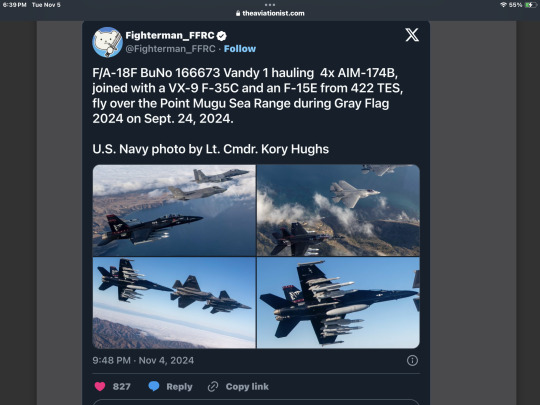
From September 17-23, Gray Flag 2024 brought together U.S. and allied forces, alongside academic and industry collaborators, for a large-scale, joint testing event hosted by Naval Test Wing Pacific and VX-9 at Naval Base Ventura County in Point Mugu, California. This year’s event saw participation from over 3,000 personnel across the Navy, Marine Corps, Army, and Air Force, executing more than 60 test initiatives. With roughly 600 aircraft sorties and more than 26 distinct systems tested on the ground, Gray Flag highlighted the vast scope of multi-domain capabilities under rigorous evaluation. Conducted on the expansive 36,000-square-mile Point Mugu Sea Range, operated by the Naval Air Warfare Center Weapons Division (NAWCWD), the event used Live, Virtual, and Constructive (LVC) test elements to simulate advanced, multi-domain combat scenarios in a controlled, realistic environment.
“Gray Flag 2024 was an unparalleled opportunity to bring together diverse branches of the military, academic institutions, science and technology experts, and allied forces,” said Capt. David Halpern, Naval Test Wing Pacific commodore.
The range of participants enabled realistic evaluation of system interoperability, informing future requirements and tactics across domains. Importantly, allied involvement was integral to the event, reflecting the coalition-based approach crucial to real-world operations. Rear Adm. Keith Hash, commander of NAWCWD and Chief of Test at Naval Air Systems Command, emphasized that integrating and operating with allies remains a strategic priority:
“The U.S. Navy operates within a global warfighting ecosystem. To deter aggression and uphold freedom of the seas, we need to test alongside our partners, just as we operate with them.”
AIM-174B
As we’ve detailed in recent months, the AIM-174B missile is a variant of the Standard Missile 6 (SM-6) repurposed for air-to-air engagements. Originally designed as the RIM-174 Standard Extended Range Active Missile (ERAM), the SM-6 serves as the U.S. Navy’s primary long-range anti-air and anti-missile defense solution, integrated with the Aegis Combat System on Navy vessels.
The SM-6 ERAM is a key asset in the Navy’s long-range air defense strategy. Derived from the RIM-156A SM-2ER Block IV airframe and equipped with an active radar seeker from the AIM-120 AMRAAM, the SM-6 is capable of reaching Mach 3.5 and has a range of 200 nautical miles in its ship-based form.
While traditionally ship-launched, the SM-6 has been tested in air-launched configurations as early as 2018 and again in 2021 on other VX-31 Super Hornets, but only this year has its deployment accelerated, with further involvement from operational units.
In April 2024, an F/A-18 was spotted carrying the AIM-174, then, on Jul. 2, 2024, an F/A-18E Super Hornet belonging to the VFA-192 “Golden Dragons” was photographed taxiing at Joint Base Pearl Harbor-Hickam, Hawaii, carrying two AIM-174B missiles marking the first appearance of the missile on a frontline platform during RIMPAC 2024. At the beginning of September, images of VX-9’s Super Hornet carrying four AIM-174s mounted on both inner and middle hardpoints, along with AIM-120s set a new benchmark for its air-to-air load capacity. Additionally, the ASG-34A IRST integrated on the fuel tank complemented the Super Hornet’s radar, providing advanced tracking capability in electronic warfare or radar-denied settings.
While details on the air-launched AIM-174B’s maximum range remain unclear, it is likely to exceed the surface-launched version when launched at altitude and speed, positioning it among the longest-range air-to-air weapons in the U.S. inventory and filling the void left by the retirement of the AIM-54 Phoenix.
Officially acknowledged in July as operationally deployed with CVW-2 aboard the USS Carl Vinson, the AIM-174B’s availability in IOC (Initial Operating Capability) extends the U.S. Navy’s reach in long-range engagement. Although publicly seen with only inert and training versions, live missiles are likely already available in the fleet.
As we explained in a previous post:
With the induction of the AIM-174B into service, the U.S. Navy joins a number of air arms capable of deploying an extra-long-range beyond-visual-range air-to-air missile (BVRAAM), like the MBDA Meteor, the Russian R-37M and Chinese PL-15 and PL-21. In fact, the AIM-174B enables the U.S. Navy Super Hornets to engage targets at much greater distances than is currently possible with the AIM-120 AMRAAM. Integrated with the E-2D, F-35, and AEGIS within the Naval Integrated Fire Control-Counter Air (NIFC-CA) system, the AIM-174B would extend the Navy’s capability to intercept aerial targets at ranges comparable to (if not greater than) those achieved against naval targets using the baseline SM-6.
In essence, this new missile fills the gap left by the retirement of the AIM-54 Phoenix. The AIM-54 was a long-range air-to-air missile used by the U.S. Navy’s F-14 Tomcat and retired in 2004 alongside the F-14. Known for its impressive range of over 100 nautical miles and multiple-target engagement capability, the AIM-54 left a significant void in long-range engagement capabilities.
While there wasn’t a direct replacement for the AIM-54 Phoenix in terms of range, the U.S. military has been developing advanced air-to-air missiles to enhance its fighter aircraft capabilities. The AIM-260 Joint Advanced Tactical Missile (JATM) is one such development intended to replace the AIM-120 AMRAAM. Although not a direct replacement for the AIM-54 Phoenix, the AIM-260 aims to offer improved range and performance compared to the AIM-120.
@TheAviationist .com
13 notes
·
View notes
Text
As the United States nears its consequential November election, concerns about the impacts of artificial intelligence on the country’s electoral integrity are front and center. Voters are receiving deceptive phone calls mimicking candidates’ voices, and campaigns are using AI images in their ads. Many fear that highly targeted messaging could lead to suppressed voter turnout or false information about polling stations. These are legitimate concerns that public officials are working overtime to confront.
But free and fair elections, the building blocks of democratic representation, are only one dimension of democracy. Today, policymakers must also recognize an equally fundamental threat that advanced technologies pose to a free and open society: the suppression of civil rights and individual opportunity at the hands of opaque and unaccountable AI systems. Ungoverned, AI undermines democratic practice, norms, and the rule of law—fundamental commitments that underpin a robust liberal democracy—and opens pathways toward a new type of illiberalism. To reverse this drift, we must reverse the currents powering it.
Liberal societies are characterized by openness, transparency, and individual agency. But the design and deployment of powerful AI systems are the precise inverse.
In the United States, as in any country, those who control the airwaves, steer financial institutions, and command the military have long had a wide berth to make decisions that shape society. In the new century, another set of actors joins that list: the increasingly concentrated group of corporate players who control data, algorithms, and the processing infrastructure to make and use highly capable AI systems. But without the kind of robust oversight the government prescribes over other parts of the economy and the military, the systems these players produce lack transparency and public accountability.
The U.S. foreign-policy establishment has long voiced legitimate concerns about the use of technology by authoritarian regimes, such as China’s widespread surveillance, tracking, and control of its population through deep collusion between the state and corporations. Civil society, academics, and journalists have recognized the threat of those same tools being deployed to similar ends in the United States. At the same time, many of today’s AI systems are undermining the liberal character of American society: They run over civil rights and liberties and cause harm for which people cannot easily seek redress. They violate privacy, spread falsehoods, and obscure economic crimes such as price-fixing, fraud, and deception. And they are increasingly used—without an architecture of accountability—in institutions central to American life: the workplace, policing, the legal system, public services, schools, and hospitals.
All of this makes for a less democratic American society. In cities across the United States, people of color have been arrested and jailed after being misidentified by facial recognition tools. We’ve seen AI used in loan refinancing charge more to applicants who went to historically Black colleges. An AI program aimed at preventing suicide among veterans prioritizes white men and overlooks survivors of sexual violence, who are much more likely to be women. Hidden behind computer code, illegal and unfair treatment long banned under federal law is becoming harder to detect and to contest.
To global observers, the trendlines of AI in American society will look familiar; the worst harms of these systems mirror the tenets of what has been called “illiberal democracy.” Under that vision—championed most famously by Hungarian Prime Minister Viktor Orban, a darling of the U.S. right—a society “maintains the outward appearances of a democracy … but in fact seeks to undermine all the institutions and norms that give democracy meaning,” scholar Susan Rubin Suleiman wrote in 2021. This doesn’t have to look like canceling elections or dismantling a sitting legislative body; instead, the vision takes the form of a more subtle assault—foreclosing the ability of individuals and minority groups to assert their rights.
As powerful new AI products are born and come of age amid a growing political alliance between far-right ideologues and some of the most powerful leaders in the technology industry, these foundational threats to free society could accelerate. Elon Musk, amplifying alarmist narratives on migrants and dehumanizing language about women and LGBT people, has said he would serve in a potential second Trump administration. Elsewhere in Silicon Valley, a growing cadre of venture capitalists are boldly betting the house on Trump in the belief that their portfolios—brimming with crypto and AI bets—may be better off under a president who is unfazed by harms to the most vulnerable and who challenges the exercise of fundamental rights.
Simply studying these tools and their effects on society can prove difficult: Scientific research into these systems is dominated by profit-motivated private actors, the only people who have access to the largest and most powerful models. The systems in question are primarily closed-source and proprietary, meaning that external researcher access—a basic starting point for transparency—is blocked. Employees at AI companies have been forced to sign sweeping nondisclosure agreements, including those about product safety, or risk losing equity. All the while, executives suggest that understanding precisely how these systems make decisions, including in ways that affect people’s lives, is something of luxury, a dilemma to be addressed sometime in the future.
The real problem, of course, is that AI is being deployed now, without public accountability. No citizenry has elected these companies or their leaders. Yet executives helming today’s big AI firms have sought to assure the public that we should trust them. In February, at least 20 firms signed a pledge to flag AI-generated videos and take down content meant to mislead voters. Soon after, OpenAI and its largest investor, Microsoft, launched a $2 million Societal Resilience Fund focused on educating voters about AI. The companies point to this work as core to their missions, which imagine a world where AI “benefits all of humanity” or “helps people and society flourish.”
Tech companies have repeatedly promised to govern themselves for the public good—efforts that may begin with good intentions but fall apart under the pressure of a business case. Congress has had no shortage of opportunities over the last 15 years to step in to govern data-centric technologies in the public’s interest. But each time Washington has cracked open the door to meaningful technology governance, it has quickly slammed it shut. Federal policymakers have explored reactive and well-meaning but flawed efforts to assert governance in specific domains—for example, during moments of attention to teen mental health or election interference. But these efforts have faded as public attention moved elsewhere. Exposed in this story of false starts and political theatrics is the federal government’s default posture on technology: to react to crises but fail to address the root causes.
Even following well-reported revelations, such as the Cambridge Analytica scandal, no legislation has emerged to rein in the technology sector’s failure to build products that prioritize Americans’ security, safety, and rights—not to mention the integrity of U.S. democracy. The same story has unfolded in the doomed push to achieve data privacy laws, efforts that have stalled out in committee ad infinitum, leaving Americans without the basic protections for their personal information that are enjoyed by people living in 137 other countries.
The Biden-Harris administration decided to push harder, through initiatives we worked both directly and indirectly on. Even before ChatGPT vaulted AI to the center of the national discourse in November 2022, President Joe Biden’s White House released an AI Bill of Rights proposing five key assurances all Americans should be able to hold in an AI-powered world: that AI technologies are safe, fair, and protective of their privacy; that they are made aware when systems are being used to make decisions about them; and that they can opt out. The framework was a proactive, democratic vision for the use of advanced technology in American society.
The vision has proved durable. When generative AI hit the consumer market, driving both anxiety and excitement, Biden didn’t start from scratch but from a set of clear and affirmative first principles. Pulling from the 2022 document, his 2023 executive order on AI mandated a coordinated federal response to AI, using a “rights and safety” framework. New rules from the powerful Office of Management and Budget turned those principles into binding policy, requiring federal agencies to test AI systems for their impact on Americans’ rights and safety before they could be used. At the same time, federal enforcement agencies used their existing powers to enforce protections and combat violations in the digital environment. The Federal Trade Commission stepped up its enforcement of digital-era violations of well-established antitrust laws, putting AI companies on notice for potentially unfair and deceptive practices that harm consumers. Vice President Kamala Harris presided over the launch of a new AI Safety Institute, calling for a body that addressed a “full spectrum” of risks, including both longer-term speculative risks and current documented harms.
This was a consequential paradigm shift from America’s steady state of passive technology nongovernance—proof-positive that a more proactive approach was possible. Yet these steps face a range of structural limitations. One is capacity: Agencies across the federal government carrying out the work of AI governance will need staff with sociotechnical expertise to weigh the complex trade-offs of AI’s harms and opportunities.
Another challenge is the limited reach of executive action. Donald Trump has promised to repeal the AI executive order and gut the civil service tasked with its implementation. If his first term is any indication, a Republican administration would reinstate the deregulatory status quo. Such is the spirit of plans reportedly drawn up by Larry Kudlow, Trump’s former National Economic Council director, to create “industry-led” task forces, placing responsibility for assessing AI tools’ safety into the hands of the powerful industry players who design and sell them.
And Biden’s measures, for the most part, guide only the government’s own use of AI systems. This is a valuable and necessary step, as the behavior of agencies bears on the daily lives of Americans, particularly the most vulnerable. But the effects of executive actions on the private sector are circumscribed, related to pockets of executive authority such as government contracting, civil rights enforcement, or antitrust action. A president’s pen alone cannot create a robust or dynamic accountability infrastructure for the technology industry. Nor can we rely on agencies to hold the line; recent Supreme Court decisions—Loper Bright, Corner Post, and others—have weakened their authority to use their mandated powers to adapt to new developments.
This, of course, is the more fundamental shortcoming of Biden’s progress on AI and technology governance: It does not carry the force of legislation. Without an accompanying push in Congress to counter such proposed rollbacks with new law, the United States will continue to embrace a largely ungoverned, innovation-at-all-costs technology landscape, with disparate state laws as the primary bulwark—and will continue to see the drift of emerging technologies away from the norms of robust democratic practice.
Yet meaningful governance efforts may be dead on arrival in a Congress that continues to embrace the flawed argument that without carte blanche for companies to “move fast and break things,” the United States would be doomed to lose to China, on both economic and military fronts. Such an approach cedes the AI competition to China’s terms, playing on the field of Chinese human rights violations and widespread surveillance instead of the field of American values and democratic practice. It also surrenders the U.S. security edge, enabling systems that could break or fail at any moment because they were rushed to market in the name of great-power competition.
Pursuing meaningful AI governance is a choice. So is the decision, over decades, to leave powerful data-centric technologies ungoverned—a decision to allow an assault on the rights, freedoms, and opportunities of many in American society. There is another path.
Washington has the opportunity to build a new, enduring paradigm in which the governance of data-centric predictive technologies, as well as the industry that creates them, is a core component of a robust U.S. democracy.
We must waste no time reaffirming that the protections afforded by previous generations of laws also apply to emerging technology. For the executive branch, this will require a landmark effort to ensure protections are robustly enforced in the digital sphere, expanding enforcement capacity in federal agencies with civil rights offices and enforcement mandates and keeping up the antitrust drumbeat that has put anti-competitive actors on notice.
The most consequential responsibility for AI governance, though, rests with Congress. Across the country, states are moving to pass laws on AI, many of which will contradict one another and form an overlapping legal tangle. Federal lawmakers should act in the tradition of the 1964 Civil Rights Act, issuing blanket protections for all Americans. At a minimum, this should include a new liability regime and guarantee protection from algorithmic discrimination; mandate pre- and post-deployment testing, transparency, and explainability of AI systems; and a requirement for developers of AI systems to uphold a duty of care, with the responsibility to ensure that systems are safe and effective.
These AI systems are powered by data, so such a bill should be accompanied by comprehensive data privacy protections, including a robust embrace of data minimization, barring companies from using personal information collected for one purpose in order to achieve an unrelated end.
While only a start, these steps to protect democratic practice in the age of AI would herald the end of America’s permissive approach to the technology sector’s harms and mark the beginning of a new democratic paradigm. They should be followed forcefully by a separate but complementary project: ensuring that individuals and communities participate in deciding how AI is used in their lives—and how it is not. Most critically, more workers—once called America’s “arsenal of democracy”—must organize and wield their collective power to bargain over whether, when, and how technologies are used in the workplace.
Such protections must also extend beyond the workplace into other areas of daily life where technology is used to shape important decisions. At a moment of weakening democratic norms, we need a new, concerted campaign to ease the path for anyone to challenge unfair decisions made about them by ungoverned AI systems or opt out of AI systems’ use altogether. This must include a private right of action for ordinary people who can show that AI has been used to break the law or violate their rights. We must also open additional pathways to individual and collective contestation, including robust, well-resourced networks of legal aid centers trained in representing low-income clients experiencing algorithmic harms.
We can bring many more people into the process of deciding what kinds of problems powerful AI systems are used to solve, from the way we allocate capital to the way we conduct AI research and development. Closing this gap requires allowing people across society to use AI for issues that matter to them and their communities. The federal government’s program to scale up access to public research, computing power, and data infrastructure is still only a pilot, and Congress has proposed to fund it at only $2.6 billion in its first six years. To grasp that number’s insufficiency, one needed only to listen to Google’s spring earnings call, where investors heard that the tech giant planned to spend about $12 billion on AI development per quarter. Next, the U.S. government should invest in the human and tech infrastructures of “public AI,” to provide both a sandbox for applied innovation in the public interest and a countervailing force to the concentration of economic and agenda-setting power in the AI industry.
These are some of the measures the United States can undertake to govern these new technologies. Even in an administration that broadly supports these goals, however, none of this will be possible or politically viable without a change in the overall balance of power. A broad-based, well-funded, and well-organized political movement on technology policy issues is needed to dramatically expand the coalition of people interested and invested in technology governance in the United States.
Ushering in these reforms begins with telling different stories to help people recognize their stake in these issues and understand that AI tools directly impact their access to quality housing, education, health care, and economic opportunity. This awareness must ultimately translate to pressure on lawmakers, a tool those standing in the way of a democratic vision for AI use to great effect. Musk is reportedly bankrolling a pro-Trump super PAC to the tune of tens of millions per month. Andreessen Horowitz, the venture firm led by anti-regulation founders, increased its lobbying budget between the first and second quarter of this year by 135 percent. Not only are the big corporate tech players spending millions of dollars on lobbying per quarter, but each is also running a political operation, spending big money to elect political candidates who will look after their interests.
The academic, research, and civil society actors whose work has helped change the tech policy landscape have succeeded in building strong policy and research strategies. Now is the time to venture further into the political battlefield and prepare the next generation of researchers, policy experts, and advocates to take up the baton. This will require new tools, such as base-building efforts with groups across the country that can help tie technology governance to popular public issues, and generational investments in political action committees and lobbying. This shift in strategy will require new, significant money; philanthropic funders who have traditionally backed research and nonprofit advocacy will need to also embrace an explicitly political toolkit.
The public interest technology movement urgently needs a political architecture that can at last impose a political cost on lawmakers who allow the illiberal shift of technology companies to proceed unabated. In the age of AI, the viability of efforts to protect democratic representation, practice, and norms may well hinge on the force with which non-industry players choose to fund and build political power—and leverage it.
A choice confronts the United States as we face down AI’s threats to democratic practice, representation, and norms. We can default to passivity, or we can use these instruments to shape a free society for the modern era. The decision is ours to make.
8 notes
·
View notes
Text
cw: selfship-coded. reader has just joined the black bulls and has water attribute recovery magic. fluff. reader and asta are both still young (pre-timeskip).
Your hand sways before you, a bubble of water traveling through space at your command. You raise your other hand and spread them apart, expanding the bubble. Slowly it widens and widens and widens as you concentrate until it is the size of your body before you, and finally, it bursts in your face, forcing a gasp from you as your clothes are drenched. It’s temporary however, and as you breathe in, the water seeps through your clothing to be reabsorbed into your skin.
Now dry, you let out a sigh of relief. You feel a little overloaded but eventually you’ll just need to pee the rest out when you equilibrate. Your Grimoire remains closed at your desk, but you’re focusing on making your lower level spells stronger and the water bubble that you’ve been able to generate and control at will for as long as you can remember much more versatile and able to cover more surface area at once.
You’ve been part of the Black Bulls for six months now, and however difficult it may have been to integrate at first, you find that things have somewhat mellowed out. While you spend a lot of time trying to temper your cousin’s bratty behavior and keep yourself from being rattled by your squadmates' overall uncouth manner of being, you’ve grown quite fond of the group, and this transition period where you’ll only be working some parts of the week and not others has finally snuck up on you faster than you expected.
Your tense conversation with Yami feels like so long ago yet so recent, where you’d leant heavily into your royal standing to get what you want, not unlike Noelle, as if it weren’t the reason you felt so stifled every day of your life. Now a part of you wonders if you shouldn’t arrange for a longer stay, to spend more time on missions with your new friends. To protect them. To return the favors granted to you by the members who taught you to fight and gave you a reason to heal fervently other than the commoners who came into the clinic in the capital.
Either way, you have a duty to uphold.
Dinnertime is served soon and Charmy’s Sheep Cooks don’t need you for a nutrition boost with your water enchantment, so you only find yourself there when everyone else is seated. Yami sits at the center of the table, and eyes you disaffectedly as you sit down, but you’ve long stopped being at odds with him.
“It’s about time that you show up,” Noelle quips, but she’s normally gentle with you.
“Say something else and I’ll get up and leave,” you reply with a wide smile, and she glances at you for a moment, then harrumphs. She hasn’t forgiven you for even considering leaving her here with the ‘brutes’ and ‘commoners’.
“It’s not like you aren’t already ditching us.”
“Hey, that’s nwo hwway to tweat our gwuest of mhwonor!” Charmy says through bites of food. Vanessa laughs through her third bottle of wine - no, liquor - while Magna and Luck return to their usual bickering with Yami not yet intervening. When you turn, you realize Gordon at some point has crept up to your other side and he’s saying something completely unintelligible. You nod politely, still with your blood running cold.
You haven’t quite figured him out yet. You try not to think about Grey at all.
Finral has figured by now that you probably won’t ever go on a date with him but he still tries from time to time to make a pass, although he’s settled for surreptitious winking. Sometimes you wonder if you should let him have a pass at you just to watch him crumble when he realizes he actually has no idea what to do with a woman once she’s accepted him.
When you slide your attention away, you realize there’s one person missing at the table, as Noelle spoons food onto her plate and then kindly, yours as well.
“Hey, where’s Asta?” you ask her.
Overreacting as usual, her face turns a deep red and the bowl of baked potatoes practically clatters as she sets it down.
“H-how should I know!?! I’m not his keeper or s-something!”
If you could roll your eyes, you would, but instead you give her a pass, then look to the rest of the group.
“I think he was out training, I don’t think he got the memo that we were having dinner early.” Finral offers, leaning in so close on the table, face propped up by his hands, he might as well be laying on it.
“Then go fucking get him,” Yami growls under his breath and suddenly the room tenses up and straightens.
Magna is out the door immediately with a “Sir, yes, Sir!” but collides right into Asta who is running in at nearly the exact same time.
“Oh shit, sorry!” he exclaims as Magna clutches his head, although his own forehead will probably start swelling shortly. The two boys make their way over to you automatically and with both hands you split your bubble and tap their foreheads gently with cooling water.
Asta is muttering apologies for missing your farewell dinner while Magna reminds him to watch where the fuck he’s going. As usual, Noelle glances at your hand on Asta’s forehead carefully before you withdraw it.
“Watch where you’re going, insect! You’re making her have to use mana unnecessarily!” Noelle also jumps in, and Magna gives her an exasperated look.
“I didn’t mean to…” Asta starts but he trails off and looks at you. You smile at him, sensing he has something to say and wonder why he’s hesitating. Asta’s loudness has a tendency to be muted around you, you feel, and you wonder why. Although you and Noelle are similar in terseness at times, you try to be kind to him as much as possible to compensate. Right now, he looks somewhat aware in addition to being somewhat disheveled and dusty, although that’s expected from someone who’s probably been swinging a sword repetitively for hours and hours.
“Does something still hurt?” you ask.
“No,” Asta starts, then scratches his head. “I-”
“Why don’t you sit down then instead of wasting time? The food’s getting cold.” Yami interjects. Asta seems to freeze in place then nods, scurrying to his seat before Noelle hisses something about cleanliness and Asta remembers to disappear to wash his hands.
When he returns, the lot of you have the planned farewell meal, moot because you’ll be back in exactly a week. Yami smokes the entire time and you remind him that the habit probably won’t be conducive to living long.
“Magic Knights aren’t exactly expecting to live to 100,” he reminds you.
“Maybe you should aim for it,” you reply. He rolls his eyes.
“Just remember that you play Doctor, it doesn’t mean you are one.”
You consider being offended, but you laugh. Magna, kind to you despite his rough exterior watches you first before deciding to laugh as well, and by the time a couple hours pass you’ve eaten and laughed your fill.
—
Before you retreat for bed, you hear a knock on the door. You expect Noelle, here to complain and possibly cry for abandoning her, but it seems that at this point she’s expended all of her pleading energy and has now decided to pretend to be unaffected. You practically slip as you tiptoe to the door, but when you re-steady yourself and open the door, you find not Noelle but Asta.
You blink and in your surprise forget to actually say anything.
Misinterpreting your surprise for annoyance, Asta seems to panic, his face reddening as he tries to explain himself.
“Hi, I, uh…” he scratches his head again like earlier, and you furrow your eyebrows.
“Is everything okay?” you ask. Adjusting the folds in your nightgown you wait for him to speak, then remember that you don’t wear a bra to bed and both of you are teenagers, crossing your arms quickly over your chest. “C-can I help you?” you add.
He turns quickly for a split second, then turns back to you. Taking a deep breath, he says quickly, lowering his eyes to the ground.
“I just wanted to say thank you for everything!”
“Everything?”
He takes another deep breath, and then in another flurry of words.
“You didn’t call me a commoner or make fun of me for not having magic! I just thought you should know I appreciated it!”
His hands are pressed to his sides very carefully as though he’s bowing to you and you find yourself both touched and embarrassed. You laugh nervously.
“I’m not doing anything more than being normal,” you remind him.
He looks up at you, and you nod.
“But Noelle and everyone else…” he pauses before you can say anything more then smiles widely, holding his head up a little higher. “Right.”
“I know we nobles can kind of suck sometimes but-” you start, but he shakes his head vigorously and you trail off.
“It’s no problem! Good night!”
Your jaw falls open just slightly as he, energetic as always, turns and speeds off.
It’s a strange encounter, and you’re never really sure what he’s thinking or what the point of all of that was really. But you think about how earnest he is, always, when he’s helping you train, when you’re healing him, when you’re simply talking.
You’ll just be gone for a week, you’ll be right back here with everyone, going on missions together. With fiery Magna, crazy Luck, sweet Charmy and Rebecca and Noelle and silly Asta.
And at the thought of that again, your own cheeks start to warm.
18 notes
·
View notes
Text
How Does The Brain Work?
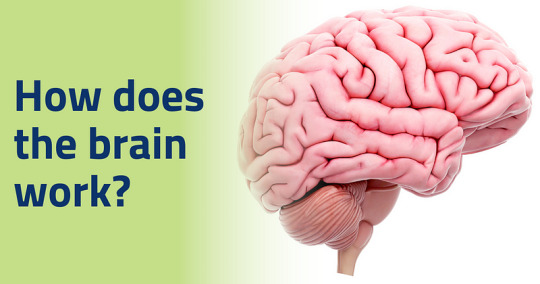
The brain stands as a marvel of biological engineering, Composing of a multitude of bodily functions ranging from cognition and memory to emotions and sensory perception. Together with the spinal cord, it constitutes the central nervous system (CNS), the command center of the human body.
Composition of the Brain
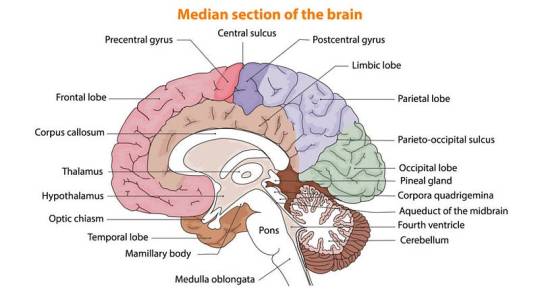
Weighing approximately 3 pounds in adults, the brain’s main structure comprises about 60% fat, interspersed with water, protein, carbohydrates, and salts. Unlike muscles, it houses a complex network of blood vessels and nerves, including neurons and glial cells.
a) Gray and White Matter
Within the central nervous system, gray matter and white matter occupies distinct regions. In the brain, gray matter forms the outer layer, rich in neuron somas, while white matter constitutes the inner section, primarily composed of axons unsheathed in myelin. Conversely, in the spinal cord, this arrangement is reversed.
b) Brain Functionality
The brain operates by transmitting and receiving chemical and electrical signals throughout the body. These signals regulate a myriad of processes, with the brain disseminating each input. Some signals remain confined within the brain, while others traverse the spinal cord and nerves, disseminating information across the body’s expanse. This composes neural network relies on billions of interconnected neurons.
Major Brain Regions and Their Functions
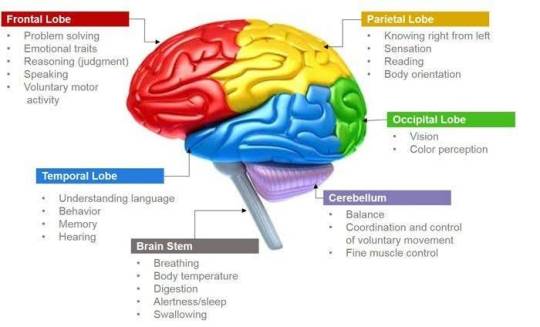
1.Cerebrum
Dominating the brain’s landscape, the cerebrum encompasses the cerebral cortex and underlying white matter. It governs a spectrum of functions, including motor coordination, temperature regulation, language processing, emotional regulation, and sensory perception.
2. Brainstem
Serving as the bridge between the cerebrum and spinal cord, the brainstem comprises the midbrain, pons, and medulla. It regulates vital autonomic functions such as heart rate, breathing, and reflexive responses.
3. Cerebellum
Nestled at the posterior aspect of the brain, the cerebellum coordinates voluntary muscle movements, posture, balance, and motor learning.
Brain Coverings
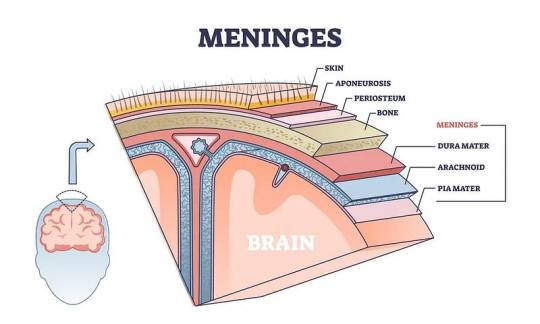
a) Meninges
Three layers of protective membranes, collectively known as meninges, enshroud the brain and spinal cord. These layers — dura mater, arachnoid mater, and pia mater — shield the delicate neural tissue from physical trauma and infection.
b) Lobes of the Brain
Each hemisphere of the brain comprises four lobes, each harboring distinct functional domains:
Frontal Lobe: Governing executive functions, motor control, and higher cognitive processes.
Parietal Lobe: Integrating sensory information, spatial awareness, and perception of pain and touch.
Occipital Lobe: Specialized for visual processing and perception.
Temporal Lobe: Involved in auditory processing, language comprehension, and memory consolidation.
Deeper Brain Structures
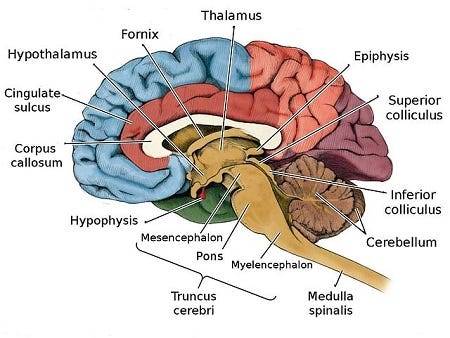
These encompass important structures such as the pituitary gland, hypothalamus, amygdala, hippocampus, and pineal gland, orchestrating hormone secretion, emotional regulation, memory consolidation, and circadian rhythms.
Blood Supply
The brain receives its oxygenated blood supply through the vertebral and carotid arteries, ensuring adequate perfusion of neural tissue. The main network of blood vessels, including the Circle of Willis, safeguards against ischemic insults and facilitates intraarterial communication.
Cranial Nerves
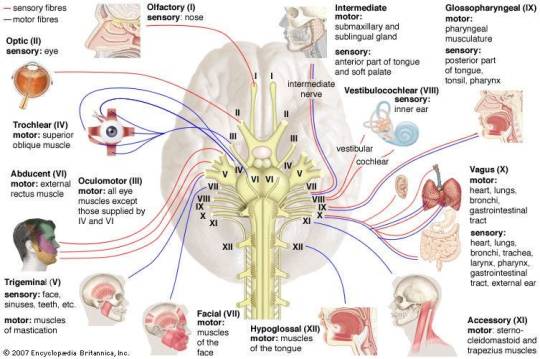
The twelve pairs of cranial nerves, originating from the brainstem, mediate a diverse array of sensory and motor functions, encompassing olfaction, vision, facial expression, and auditory perception.
Comprehending the anatomy and functionality of the brain fosters a deeper appreciation of its complexity and facilitates advances in neuroscientific research and therapeutic interventions aimed at diminishing neurological disorders.
Understanding the detailed anatomy and functionality of the brain is crucial for medical students embarking on their journey of study. Expert Academic Assignment Help offers invaluable assistance in navigating the complexities of neuroscience and related subjects. By leveraging expert guidance and support, students can excel in their medical education and contribute to advancements in the field of Medicine. Email us at [email protected] to embark on your path to scholarly excellence and professional competency.
#studying#studyblr#study blog#study aesthetic#student life#student#medical student#medical school#medicine#university student#university#university life#assignment help#medical students#nursing student#nursing school#healthcare#health and wellness#mental health#psychology#phd life#phd thesis writing service#online writing#do my online class#academic writing#essay writing#academic assignments#academia
12 notes
·
View notes
Text
Sundara's Whispers of Transformation

In the heart of bustling Mumbai, where the city's pulse reverberates through crowded streets and towering skyscrapers, Sundara, a determined and disciplined young woman, found solace in the Energize Fitness Center. The rhythmic beats of the metropolis served as a backdrop to her relentless pursuit of physical and mental well-being.Unbeknownst to Sundara, a mysterious man observed her from the shadows. His motivations, shrouded in secrecy, revolved around a desire to weave subtle threads of influence into the fabric of her life. Intrigued by her dedication, he saw in Sundara a canvas ready to be painted with the hues of transformation.Their initial meeting was serendipitous, a chance encounter amid the clinking of weights and the hum of treadmills. The mysterious man, his face obscured by an air of enigma, skillfully merged hypnotic suggestions with workout guidance. Engaging Sundara in seemingly innocuous conversations, he planted the seeds of influence that would soon bloom into a profound connection.The hypnotist's methods were a carefully crafted dance of words and gestures, a delicate interplay of suggestion and consent. His hypnotic inductions during their interactions were subtle, seamlessly integrated into the rhythm of Sundara's workout routine. Each whispered command, each subtle suggestion, took root in the fertile soil of her subconscious.As the days unfolded, Sundara's eyes, once vibrant brown, began to betray the transformation occurring within. Under the influence of the hypnotist's subtle artistry, they took on an otherworldly white glow whenever the trance took hold, a visual manifestation of the unseen forces at play.The nightly rituals became the cornerstone of Sundara's metamorphosis. In the dimly lit corners of her home, guided by the hypnotist's commands, she underwent a profound change. Her thoughts, once characterized by assertiveness, now flowed with a newfound submission, moulded by the intricate dance of influence.

Sundara, under the trance, became a different entity. Her personality, once marked by determination, now bore the imprint of the hypnotic whispers. Submissive, pliant, and perpetually in the thrall of the mysterious man's influence, she navigated her dual existence with a silent grace.The city of Mumbai, with its teeming millions, remained oblivious to the mystical change enveloping Sundara. She moved through crowded streets and bustling markets, her eyes betraying the secret only the hypnotist held. The name "Sundara" echoed with a haunting resonance, a testament to the whispered transformation that had become an integral part of her existence.

As Sundara continued her routines, the hypnotist's influence deepened, guiding her through the intricacies of a life sculpted by his commands. Her interactions became a symphony of hypnotic undertones, with each conversation weaving threads of control that bound her tighter to his will.The mysterious man, content in his hidden power, revelled in the transformation he had orchestrated. He steered Sundara's life, subtly influencing her decisions, and moulding her reality to align with his desires. The dual existence continued – the vibrant woman in the daylight, the submissive puppet under the cover of night.Sundara's interactions with the world became a delicate dance, a choreography of controlled responses and scripted movements. The hypnotic whispers resonated in her mind, guiding her steps, dictating her words, and shaping her destiny. The city of Mumbai, blissfully unaware, carried on its daily rhythm, unknowingly housing the silent convergence of two destinies.As the days turned into weeks, and the weeks into months, Sundara's metamorphosis reached its zenith. The hypnotist, satisfied with his creation, chose a final command to etch her destiny permanently. On a moonlit night, in the solitude of her home, he whispered the words that would bind her in perpetual submission.
"Sundara, your existence is intertwined with my will. You are forever under my command, a vessel of whispered influence. Your eyes shall remain white, a testament to the silent power that guides you. Go forth, live your life, and remain my eternal creation."With those words, Sundara's fate was sealed. The hypnotic trance, once a subtle undercurrent, now became an indelible part of her being. The city of Mumbai, with its oblivious residents, continued to pulse with life, as Sundara moved through its streets, her eyes forever betraying the secret they held.In the quiet corners of her home, Sundara existed in a state of perpetual trance, a vessel forever under the influence of the mysterious hypnotist. Her name echoed through the corridors of her consciousness, a haunting reminder of the whispered transformation that had rewoven the fabric of her existence.
#mind corruption#hypnotist#hypnotized#brainwashing#hypnotized girl#surrender#mind control#mind conditioning#hypnotic#hypno sub#hypnofetish#hypnosis#mindless
34 notes
·
View notes
Text
Helmet Capabilities
The standard-issue helmet for the cadets in the Enforcer Academy is a multifunctional headgear designed to provide protection, communication, and situational awareness. The helmet is an integral component of the full-body armor system and offers the following capabilities:

Protection and Construction
Material: Constructed from a composite of high-strength polymers and lightweight alloys, the helmet offers excellent ballistic protection while remaining lightweight.
Ergonomics: The interior is padded with adjustable, high-density foam to ensure a secure and comfortable fit for extended wear.

Visor System
Retractable Visor: The helmet features a retractable, polycarbonate visor that can be deployed or retracted with a simple voice command or manual switch. The visor is impact-resistant and provides full facial protection.
Heads-Up Display (HUD): When the visor is deployed, it functions as a transparent display, overlaying critical information directly onto the user's field of vision. The HUD includes data such as ID overlays of other cadets, navigation aids, environmental readings, and communication messages.

Communication
Integrated Communications Suite: The helmet is equipped with a built-in communication system, allowing for helmet-to-helmet communication among cadets and instructors. This includes individual, group, and broadcast modes.
External Noise Control: The helmet can either fully block outside noise or allow selective sounds, such as authorized speech, to pass through. This feature ensures clear communication while maintaining situational awareness.

Sensory Input Management
Noise Dampening: Blocks out external noise when necessary, with adjustable settings to allow selective auditory input.
Visual Filters: Can dim, block or enhance visual input based on the cadet’s environment, reducing sensory overload.
AI Monitoring: The helmet’s integrated AI monitors conversations, filtering out unauthorized or harmful communications and providing real-time feedback.
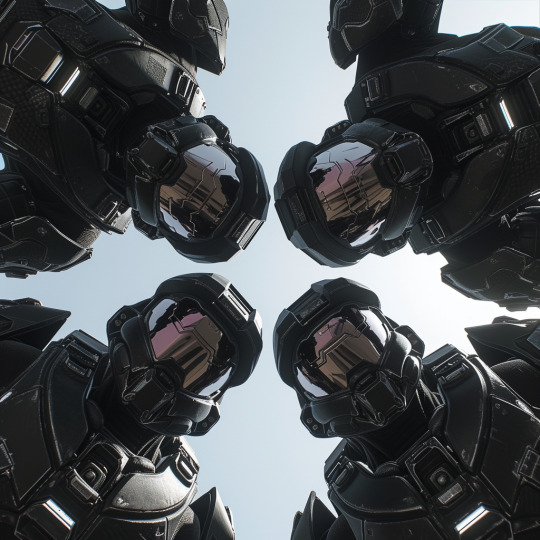
Sensors and Monitoring
Environmental Sensors: The helmet includes sensors to monitor external conditions such as temperature, humidity, and air quality, providing real-time data to the wearer and the command center.
Biometric Monitoring: The helmet continuously monitors vital signs, including heart rate, respiration, and stress levels, transmitting this data to the central monitoring system.

Safety and Security
Neck Seal: The helmet features an airtight neck seal that integrates with the body armor, ensuring a complete protective barrier against hazardous environments.

Additional Features
Night Vision and Thermal Imaging: The helmet is equipped with night vision and thermal imaging capabilities, allowing for enhanced visibility in low-light or obscured conditions.
Custom Fit: The padding and internal structure can be adjusted to fit various head sizes and shapes, ensuring a custom fit for each cadet.

Usage and Maintenance
Battery Life: The helmet's power supply is integrated with the suit's main power system, providing continuous operation for up to five days without recharging.
Maintenance: Regular maintenance includes cleaning the visor, checking the seals, and ensuring the communication systems are functioning properly. Maintenance protocols are outlined in the standard operating procedure manual.
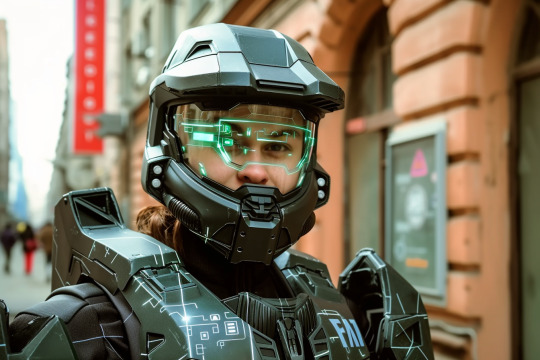
Remote Control and Safety Features
Instructor Control: Instructors can remotely control helmet functions, including visual and auditory inputs, to ensure cadet safety and compliance.
Emergency Lockdown: The helmet can immobilize the cadet’s head and control movements via the neural interface in critical situations.

Usage Parameters
Operational Duration: Designed for continuous use up to 7 days, with standard operational periods of 5 days.
Maintenance Cycle: Requires a maintenance check and recalibration after each operational cycle to ensure optimal performance.

5 notes
·
View notes
Text

What’s It Like to Work in NASA’s Mission Control Center?
In the latest installment of our First Woman graphic novel series, we see Commander Callie Rodriguez embark on the next phase of her trailblazing journey, as she leaves the Moon to take the helm at Mission Control.

Flight directors work in Mission Control to oversee operations of the International Space Station and Artemis missions to the Moon. They have a unique, overarching perspective focused on integration between all the systems that make a mission a success – flight directors have to learn a little about a lot.
Diane Dailey and Chloe Mehring were selected as flight directors in 2021. They’ll be taking your questions about what it’s like to lead teams of flight controllers, engineers, and countless professionals, both agencywide and internationally, in an Answer Time session on Nov. 28, 2023, from noon to 1 p.m. EST (9-10 a.m. PST) here on our Tumblr!
Like Callie, how did their unique backgrounds and previous experience, prepare them for this role? What are they excited about as we return to the Moon?
🚨 Ask your questions now by visiting https://nasa.tumblr.com/ask.
Diane Dailey started her career at NASA in 2006 in the space station Environmental Control and Life Support Systems (ECLSS) group. As an ECLSS flight controller, she logged more than 1,700 hours of console time, supported 10 space shuttle missions, and led the ECLSS team. She transitioned to the Integration and System Engineering (ISE) group, where she was the lead flight controller for the 10th and 21st Commercial Resupply Services missions for SpaceX. In addition, she was the ISE lead for NASA’s SpaceX Demo-1 and Demo-2 crew spacecraft test flights. Dailey was also a capsule communicator (Capcom) controller and instructor.
She was selected as a flight director in 2021 and chose her call sign of “Horizon Flight” during her first shift in November of that year. She has since served as the Lead Flight director for the ISS Expedition 68, led the development of a contingency spacewalk, and led a spacewalk in June to install a new solar array on the space station. She is currently working on development of the upcoming Artemis II mission and the Human Lander Systems which will return humanity to the moon. Dailey was raised in Lubbock, Texas, and graduated from Texas A&M University in College Station with a bachelor’s degree in biomedical engineering. She is married and a mother of two. She enjoys cooking, traveling, and spending time outdoors.
Chloe Mehring started her NASA career in 2008 in the Flight Operations’ propulsion systems group and supported 11 space shuttle missions. She served as propulsion support officer for Exploration Flight Test-1, the first test flight of the Orion spacecraft that will be used for Artemis missions to the Moon. Mehring was also a lead NASA propulsion officer for SpaceX’s Crew Dragon spacecraft and served as backup lead for the Boeing Starliner spacecraft. She was accepted into the 2021 Flight Director class and worked her first shift in February 2022, taking on the call sign “Lion Flight”. Since becoming certified, she has worked over 100 shifts, lead the NG-17 cargo resupply mission team, and executed two United States spacewalks within 10 days of each other. She became certified as a Boeing Starliner Flight Director, sat console for the unmanned test flight in May 2022 (OFT-2) and will be leading the undock team for the first crewed mission on Starliner in the spring of next year. She originally is from Mifflinville, Pennsylvania, and graduated with a bachelor’s degree in aerospace engineering from The Pennsylvania State University in State College. She is a wife, a mom to one boy, and she enjoys fitness, cooking and gardening.
#answertime#NASA#flight director#First Woman#astronaut#Artemis#Orion#graphic novels#comics#spaceblr#women in STEM#STEM#NASA women#CallieFirst
2K notes
·
View notes
Text

my decades challenge index
Sul sul!
I have begun two different Decades Challenges, one I played from 1890 to 1960 and the other I didn't make much progress in. In both of these, I realized that I'm too much of a control freak and needed to do more prep before committing to the challenge!
Thus, I've indexed all of my hard work below in case you, too, are looking to control everything like I am :) I will update as I find new mods and items that improve my gameplay
Last Update 7/6/2024

I am using a mix of various rules from different creators.
IllusoryThrall's Decade's Challenge (Hard Mode) for starting money, starting age, and MCCC settings*
MorbidGamer's spreadsheets, death rolls, and aging (I'll be using four sim days per year rather than IllusoryThrall's two sim days per year)
Finally, a mix of IllusoryThrall and cutecoffeegal's Decades Challenge Rules for each decade of active gameplay guidelines
some extra details - I highly recommend MorbidGamer's spreadsheets for keeping track of everything, you can find them linked in the Google Doc for the challenge; I am not starting in 1300, so I deleted all of the cells in my copy until 1890 - I'm making minor changes to IllusoryThrall's rules as far as their gameplay settings, but I am using their holidays - Likewise, I'm making some small changes to cutecoffeegal's standard rules for personal preference towards storytelling, so I might allow an heir to be a woman depending on the story I wish to tell

I have lots of experience with mods, but this challenge requires more tuning than I'm used to. I've tried to lay everything out here for you! If you need it, here's a quick tutorial on how to put mods and custom content in your game
CORE MODS
deaderpool's MC Command Center : I used IllusoryThrall's MCCC Settings for gameplay, you'll need to adjust these settings through a computer on your lot; if you're going to have any mod, I would recommend this above all
roburky's Meaningful Stories : Adds depth to the experiences of my sims
Realistic Gameplay (alphabetized)
adeepindigo's Healthcare Redux : I love adeepindigo's mods, they integrate so well with the game; I'm only using Healthcare Redux for now to simulate realistic sickness and medical care
BrazenLotus's Harvest & Gather, Crafting, and Food & Drink : Another great mod that allows you to farm, craft, preserve, and cook in a more period-appropriate way; it took me a while to get this working how I wanted, but it's so worth it
chingyu's 100 Base Game Traits : The lack of traits in Sims 4 is one of my biggest complaints, so I broke the rules of the challenge a bit to give my sims more interesting, life-impacting traits while keeping close to the decade
ClaudiaSharon's No Autonomous Anything : So my sims stop taking selfies and texting people in 1890
ClaudiaSharon's No Festival Notifications : So I'm not pestered with festivals I can't attend yet
Frankk's Language Barriers : More realism to sims being from different worlds; !!be sure to follow his download instructions very carefully!!
Kuttoe's Enlist in War : For war realism
Kuttoe's Home Regions : To simulate contact only between sims in one world before common travel
Littlbowbub's Ye Olde Cookbook Kit : A great mod that lets you forage, hunt, and cook meals with new oven animations, lifesaving if you're playing with Simple Living
Lumpinou's Mood Pack : This is a required mod for a number of other mods to work that give custom moods and moodlets to your sims; I use it for chingyu's Base Game Traits
LittleMsSam's Auto-Employees : A lot trait you can use to populate vendor stalls on lots you create, a HUGE lifesaver for my Simple Living sims
maplebell More CAS Traits : serves the same purpose as chingyu's mod!
MizoreYukii's Children/Toddlers Can Die of Anything : For realism and death roll compliance
MizoreYukii's Remove Hats Indoors : An item that allows you to set hat and glove rules inside, functions like the shoe sign from Snowy Escape
Pandasama's Childbirth Mod : For realism in childbirth
RVSN's ISO LovePhotos Camera : I use this to take portraits in-game
SimplyAnjuta's No Makeup/Accessories on Randomized Sims : Keeps my townies from looking deranged
SimRealist's Mortem, Sim National Bank, Financial Center ,and Private Practice: I use these mods for realism in dealing with money and sim death as well as building a functioning bank/clinic, it takes some finagling to hide the required computers in the venue, but I really appreciate the structure it gives my game
TURBODRIVER's Wonderful Whims : For realism in relationships, woohooing, and menstruation
The Peridot Project's Shorter University Mod [4 credits] : I use this mod to remain true to the timing of the challenge; 4 credits/2 weeks simulates four years in-game
Triplis's Quit or Join School : In case I need my teens to quit school
Overrides !!I recommend keeping your overrides separate from mods in your game folder!!
pandorasimbox's Timeless Mod surely-sims Invisible Crib kat-simss' Historical Homework Defaults extrellka-chipsa's Fire Extinguisher Replacement MoonSimmers' Victorian Books Override 20thCenturyPlumbob's Map Replacements CowplantSnacks' Historical Replacements (Scouts) Savythatsimmer's Henford River Loading Screen Magnolian Farewell's Take the Lead Leash Replacement motherof70's Bug Spray and Trash Replacements MorbidGamer's Present Override Surely-Sims' 1900s Millinery CAS Backgrounds (I use Lace) xbrilliantsims' Toddler Bathtime Overrides Cepzid Creation's Functional Cottage Living Phonebooth MizoreYukii's Functional Broom JaneSimsten's Parchment Computer
Poses all used with Andrew's Studio Pose Player and scumbumbo's Teleport Any Sim (I also use Twisted Mexi's Searchable Pose Player)
Minty_Mint's Large Farm Family Portrait, Town Family Portrait, and Farm Family Portrait scythesims' Victorian Children Posepack, Part II, and Victorian Family Portraits Posepack EllieMaySims' Pose Pack Old Photos kat_simss' Old Family Picture Posepack lucky-content's Wedding Poses TheRoyalSims' Old Timey Couple Posepack RevolutionSims' Portrait Poses TwentiethCenturySims' Embroidery Posepack
Misc Mods Scumbumbo's XML Injector weerbesu's UI Cheats Extension TwistedMexi's Better Exceptions SrslySims' Simulation Lag Fix

There is too much custom content in my game to possible put it all here, but I am going to list some of my favorite creators and simblrs for you to browse
BatsFromWesteros Vintage Simstress Vintage-Simmer Medieval Sim Tailor & Carpenter retropixels SFS Archive Linzlu & SFS Archive historicalfictionsims ChèreIndolente Moon-Simmers JewishSimming cmoonsims historicalsimslife cringeborg GildedGhosts & SFS Archive peebs pandorasimbox AmeyaSims lonelyboy the-melancholy-maiden joliebean Out of Fashion Cepzidbuzzardly28Sauruslilis-palace (FOLKLORE, INTARSIA, BUDAPEST)plasticbox's Washing Bowl syboulette

Currently Testing... Lot 51's Fashion Authority Mod
Current Game Stats: Arthur & Clara Wright 1890 (Day 1)
World Stats:Windenburg Landgraab Bank and Clinic, Oak Lane Schoolhouse, Windenburg Congregational, Windenburg Town Hall, The Knight's Arms Restaurant, Landgraab Shoppes, H. Licht Fine Photography, Town Centre Tavern
Townies:The Von Windenburg Family [The Von Windenburg Estate] - Byron Von Windenburg, Pearl Von Windenburg, Eugene Von Windenburg, Harmony Von Windenburg, Mabel Von Windenburg, Dahlia Rheinfrank (nanny), Joelle Whitlock (tutor) The Gallagher Family [14 Willow Lane]- George Gallagher, Louise Gallagher, Jerome Gallagher The Parsons Family [6 Oak Lane] - Matthias Parsons, Juliette Parsons
Some more information on MCCC Dresser functions - follow the instructions to save outfits then automate them on age-up for unplayed sims; it's a time suck, but makes your gameplay much more immersive, in my opinion

from IlluoryThrall's Rules
Gameplay Options:Autonomy: Off Disable autonomy for selected sim: off Auto-age played sims: no Auto-age unplayed sims: no Sim Lifespan: Long Maximum sim count: at your discretion Fill empty homes: also at your discretion Show whims: on Build mode items grant gameplay bonuses: on
Environment:8 Day Lunar Cycle Permanent Phase Disabled Disable lunar effects OFF Season Length: 7 Days Rain and thunderstorms Snow and Blizzards Enable temperature effects on Sims: on Enabled Thundersnows: on Enable Icy conditions: on
Pack Settings: Get Famous: disabled until the 1910s Eco Lifestyle: disabled on both options until 1970s Bust the Dust disabled until the 1920s Werewolves must be locked to Moonwood Mill (although deleting them might be useful, as well.) High School Years: Enable both options (Following Teens to school is forbidden until the 1920s or after, at your discretion.) Growing Together: both options enabled
#sims 4#sims 4 decades challenge#sims decades challenge#thegoopycarbonara decades challenge#ts4 decades challenge#decades challenge#the wright legacy
11 notes
·
View notes
Text
Function of Brain Stem
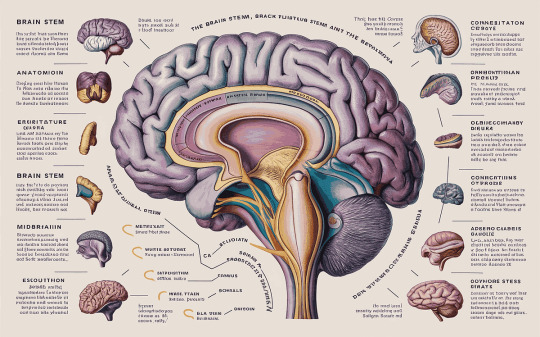
Introduction
The brain stem, often referred to as the “gateway to the brain,” is a vital component of the central nervous system responsible for regulating essential bodily functions and facilitating communication between the brain and the rest of the body. Comprising the midbrain, pons, and medulla oblongata, this intricate structure plays a crucial role in sustaining life and maintaining homeostasis.
1. Regulation of Basic Life Functions
At the core of its function, the brain stem governs fundamental physiological processes necessary for survival, including heartbeat, respiration, and blood pressure regulation. The medulla oblongata, situated at the base of the brain stem, serves as a control center for autonomic functions, such as breathing rate and heart rhythm, by monitoring sensory input and orchestrating appropriate responses.
2. Conduction Pathway for Sensory and Motor Signals
As a conduit between the brain and the spinal cord, the brain stem serves as a relay station for sensory information from the body to the brain and motor commands from the brain to the body. Nerve fibers ascend through the brain stem carrying sensory impulses towards the brain for processing, while descending fibers convey motor signals from the brain to the spinal cord, coordinating voluntary movements and reflex actions.
3. Integration of Reflexes
The brain stem plays a pivotal role in mediating reflex actions, automatic responses that occur in response to specific stimuli without conscious effort. Reflex arcs involving sensory receptors, afferent nerves, interneurons within the brain stem, and efferent nerves facilitate rapid, involuntary reactions to stimuli, such as withdrawing from pain or adjusting posture to maintain balance, ensuring swift and adaptive responses to environmental changes.
4. Control of Arousal and Consciousness
Crucially, the brain stem regulates levels of consciousness and arousal, exerting influence over wakefulness, alertness, and sleep-wake cycles. The reticular formation, a network of nuclei spanning the brain stem, modulates neural activity to promote wakefulness during periods of stimulation and facilitate transitions into sleep or altered states of consciousness, underscoring its pivotal role in regulating the overall level of cognitive awareness.
5. Coordination of Cranial Nerve Functions
Integral to its function, the brain stem houses nuclei responsible for controlling several cranial nerves involved in sensory perception, motor control, and autonomic regulation of organs in the head and neck region. By coordinating the activities of these cranial nerves, the brain stem facilitates crucial functions such as vision, hearing, facial expressions, swallowing, and maintaining cardiovascular and respiratory homeostasis.
6. Facilitation of Postural Control and Balance
Moreover, the brain stem contributes to postural control and balance through its connections with the cerebellum, a structure located at the base of the brain. By integrating sensory feedback from the body and coordinating motor commands, the brain stem helps maintain stability and equilibrium, enabling smooth and coordinated movements essential for navigating the environment safely.
7. Modulation of Autonomic Functions
Additionally, the brain stem modulates autonomic functions, regulating visceral activities such as digestion, urination, and sexual arousal through its influence on the autonomic nervous system. Sympathetic and parasympathetic pathways originating in the brain stem orchestrate physiological responses to stress, rest, and various internal and external stimuli, ensuring adaptive adjustments to maintain internal balance and respond to changing environmental demands.
8. Regulation of Cardiovascular and Respiratory Functions
Furthermore, the brain stem plays a central role in regulating cardiovascular and respiratory functions, ensuring the delivery of oxygen-rich blood to tissues and organs and maintaining optimal gas exchange in the lungs. Through specialized nuclei and reflex pathways, the brain stem modulates heart rate, blood pressure, and breathing patterns in response to physiological needs and environmental cues, safeguarding vital organ perfusion and metabolic balance.
9. Contribution to Neuroendocrine Control
Lastly, the brain stem contributes to neuroendocrine control by serving as a bridge between the nervous system and the endocrine system. Hypothalamic nuclei within the brain stem integrate neural and hormonal signals, regulating the release of pituitary hormones that govern various physiological processes, including growth, metabolism, reproduction, and stress responses, thereby exerting profound influence over systemic homeostasis and adaptation.
Conclusion
In summary, the brain stem embodies the intricate interplay between neural structures and physiological functions, serving as a linchpin of the central nervous system’s regulatory machinery. Its diverse roles encompass vital autonomic, sensory, motor, and integrative functions essential for maintaining life, consciousness, and adaptive responses to internal and external stimuli. Through its complex networks and dynamic interactions, the brain stem exemplifies the remarkable complexity and resilience of the human brain, underscoring its paramount importance in sustaining health, vitality, and cognitive function.
FAQs
1. What is the primary function of the brain stem? The brain stem is responsible for regulating essential physiological functions, including breathing, heart rate, and blood pressure, as well as controlling basic involuntary movements like swallowing and vomiting.
2. How does the brain stem connect the brain to the rest of the body? The brain stem serves as a conduit between the brain and the spinal cord, facilitating the transmission of sensory and motor signals to and from the body’s peripheral nervous system.
3. What are the major anatomical divisions of the brain stem? The brain stem comprises three main regions: the medulla oblongata, the pons, and the midbrain, each with distinct structures and functions contributing to overall neural regulation and coordination.
4. How does the brain stem contribute to consciousness and arousal? The reticular formation, a network of nuclei located throughout the brain stem, plays a critical role in regulating wakefulness, attention, and arousal levels by modulating the activity of cortical and subcortical brain regions.
5. What happens when the brain stem is damaged? Damage to the brain stem can result in profound neurological deficits, including loss of consciousness, impaired vital functions such as breathing and heart rate, and disturbances in sensory and motor control, depending on the extent and location of the injury.
10 notes
·
View notes
Text

USAF Should Look At China’s Future Multi-Crew Fighter Model For F-15EX
The F-15EX's currently empty rear cockpit needs to be taken advantage of by adding a new kind of second crewmen, an Air Mission Commanding Officer.
Major Joshua “Soup” Campbell Posted on Jul 25, 2024 11:24 AM EDT Edited By Tyler Rogoway
F-15EX and J16, both two seaters, but one uses the second crewman in a different capacity than the traditional weapon system officer role.
PLA/USAF
Amidst strategic shifts in its force posture, the U.S. Air Force (USAF) faces pivotal decisions on the deployment of its next-generation fighter fleet. With plans to retire aging F-15C/D Eagles and scale back F-15E Strike Eagle operations, the USAF is poised to integrate a limited number of F-15EX Eagle IIs into the fleet. Yet, while the F-15EX boasts advancements as an evolution of the F-15E Strike Eagle family of fighters, current strategies overlook the aircraft’s rear cockpit potential.

The first F-15EX Eagle II delivered to the Oregon Air National Guard’s 142nd Wing, the first operational unit to receive the type, touches down in Portland in June 2024. 142nd Wing/Oregon Air National Guard
Meanwhile, the People’s Liberation Army Air Force (PLAAF) advocates for multi-seat configurations to manage data-rich combat environments effectively. USAF plans, on the other hand, currently exclude utilizing the F-15EX’s rear cockpit, limiting its role to air-to-air missions and possibly limited air-to-ground missions sometime in the future.
In this era of transformative air combat, as the PLAAF pioneers new operational concepts with multi-seat fighters, the USAF stands at a crossroads, balancing legacy strategies with the imperative for adaptive, integrated command and control of unmanned systems and network-centric operations. With the F-15EX, however, the USAF has an opportunity to lead the way regarding future air combat by fully embracing the Eagle II’s two-crew capability.

The Eagle II Opportunity
With the pending divestment of the F-15C/D and reduction of the F-15E inventory, the USAF has committed to purchasing a relatively small number of F-15EXs to replace the F-15C/D in Japan, as well as at three National Guard bases with units tasked with U.S. homeland defense. The Eagle II, however, evolved from the Strike Eagle and subsequent F-15 derivatives, is capable of far more than what the legacy Eagle fleet previously provided to combatant commanders.
Given its modernized sensors, self-protection suite, fiber optics, future integration of an open mission system and digital open architecture backbone, more powerful engines, increased computing capabilities, and the inclusion of a rear fully-missionized cockpit, the F-15EX represents a significant advancement over both the F-15C/D and F-15E. Yet, current operational plans do not involve taking advantage of the rear cockpit, leaving it empty and unused, assigning the F-15EX to perform long-range and medium-range air-to-air only missions with minimal expansions into other missions sets the F-15EX is purpose-built to fulfill.

From left to right, an F-15C, an F-15E, and an F-15EX. USAF
The evolving character of air combat, however, demands that platforms do more amongst the growing complexity of high-end warfare. When considering the future of air combat, which places information at center stage in a high-end conflict, failing to utilize the rear cockpit would be a missed opportunity to expand future roles and responsibilities of the F-15EX, disregarding the investment that already exists in the aircraft’s capabilities.
By contrast, People’s Liberation Army Air Force (PLAAF) assessments of the anticipated complexities of forthcoming high-end combat environments have led them to identify multi-seat, multi-role configurations as critical to operations.
Available information suggests that the PLAAF believes an additional operator offers the potential for more effective interpretation and utilization of the vast sensory data that could overwhelm the cognitive and processing capacities of a single individual, particularly in the future of contested air combat environments. Having made this assessment, the PLAAF is now moving forward in developing operational concepts for how best to employ multiple operators in a single tactical aircraft, like the J-16 and the two-seat J-20S variant (also referred to variously as the J-20B and J-20AS), beyond their traditional roles. The USAF could benefit from adopting a multi-operator approach like the PLAAF’s with the F-15EX.

A picture of a two-seat J-20 during testing. Chinese internet
Information Saturation
Any future high-end conflict will produce vast amounts of data that need processing. Both the U.S. military and PLA continue to develop robust integrated intelligence, surveillance, and reconnaissance (ISR) networks to facilitate combat operations and support long-range kill chains. As such, sensors within the land, sea, air, and space domains will provide more data than can be consumed by human operators to process — and make accurate — real-time tactical and operational decisions. Due to the rapidly changing environments in a future contest, these decisions will need to be made quickly and potentially at the forward edge of the battlespace.
In an anticipated information-saturated environment, the USAF advocates for the integration of artificial intelligence (AI) and machine-to-human collaboration to alleviate the workload and cognitive demands on operators. While the incorporation of AI may process and distill information to provide operators with pertinent data, a saturated, complex combat environment full of adversary ships, aircraft, and coastal defenses employing deception and denial tactics will still likely result in an overwhelming influx of information for operators to process, leading to task saturation. Performing a multitude of missions and tasks — including controlling collaborative combat aircraft (CCA) and managing other aircraft in formation — all the while making air-to-air and air-to-ground engagement decisions within a contested, degraded, and operationally limited (CDO-L) environment will challenge and could exacerbate cognitive processes for both humans and their AI agents. The PLAAF, on the other hand, seems to be intent on leveraging AI integration with more human operators, not less.

Public Domain
Moving Beyond Traditional Roles
A recent article published in January 2024 by Chinese state-owned outlet Ta Kung Pao Online in Hong Kong, titled “J-16 Leads the Air Force Aircraft Fleet in Preparations for Future Air Battles,” sheds light on the evolving role of the J-16 back-seater and its implications for the future role of the J-20S back-seater. The article outlines the traditional division of responsibilities between front-seat and back-seat operators in the J-16. It also underscores how, due to evolving characteristics of air warfare, the role of the backseat operator has evolved as combat has evolved, informing future J-20S operations.

A Chinese J-16. Japan Ministry of Defense A stock picture of a Chinese J-16. Japan Ministry of Defense
According to the article, the J-16 stands out as the primary two-seat fighter in the PLAAF’s combat air force. While the two-seat Su-30 Flanker exists in the PLAAF’s inventory, its fleet is smaller in size, whereas the J-16 contains more advanced avionics and is in continued domestic production exceeding 245 aircraft, leaving the PLAAF to rely heavily on the J-16 and its more advanced capabilities.

A Chinese Su-30MKK Flanker. Dmitriy Pichugin A stock picture of a Chinese Su-30MKK Flanker. Dmitriy Pichugin
Equipped with asymmetric, outsized weapons that don’t fit in the J-20’s weapons bay, the J-16 provides a broad array of operational capabilities, making it a versatile asset in various scenarios. Similar to the F-15E, the J-16 conducts long-range air-to-air engagements and attacks on ground and maritime targets where the back-seater serves as a weapons controller responsible for employing different types of weapons. The PLAAF, however, is beginning to adapt the J-16 to the expected information-dominated combat environment and evolving manned-unmanned teaming by developing new roles and responsibilities for the aircraft and its operators.
Information-Dominated Combat Environment
In the context of the evolving landscape of networked and unmanned warfare, contemporary air combat will incorporate a multitude of systems where all combat elements are interconnected with vast amounts of information. Through data transmission and intelligence-sharing platforms, collaborative operations based on interconnected systems have become the predominant operational model, with the J-16 capable of assuming the central command role for entire formations. According to the Ta Kung Pao article, the J-16 back-seater, in this new environment, evolves from simply a “weapon controller” into an “air mission commanding officer.”
A close-up look at the pilot and the back-seater in a Chinese J-16. China Military Online/Liu Chang and Liu Yinghu
With this new evolution, the air mission commanding officer (AMCO) encompasses multiple roles and responsibilities in a high-tech conflict that includes overseeing air-to-surface weaponry, managing and disseminating multi-platform intelligence, and issuing operational directives. While this may seem similar to the USAF’s airborne Forward Air Controller-Airborne (FAC[A]), there appear to be differences in employment concepts between the PLAAF’s AMCO and the USAF’s FAC(A), particularly regarding the operational environments with which they are utilized.
Primarily employed in close air support (CAS) or strike coordination and reconnaissance (SCAR) missions, the FAC(A) is the airborne version of a joint terminal air controller (JTAC) in which both can nominate and mark targets, deconflict airspace, relay critical ground schemes of maneuver, and authorize airstrikes. The PLAAF’s AMCO, however, seems to focus on roles and responsibilities that leverage the PLA’s sensing network in a contested air interdiction environment.
Utilizing the PLA’s expanding sensing network to build situational awareness in the battlespace, the J-16 back-seater, assuming the AMCO role and plugged into the sensing network, is intended to direct coordinated efforts among various aircraft, in conjunction with ground and naval units, to execute comprehensive aerial attacks. Additionally, the back-seater’s role is to command and coordinate multiple drones acting as ‘loyal wingmen’ with the intent to amplify combat effectiveness through combined manned and unmanned operations.
Whether or not the PLAAF is actually proficient with this type of force package integration in a high-end combat environment remains to be seen. There is a distinct possibility that the PLAAF is overstating its capabilities in such an environment and much of this training is nascent or scripted, or this is the aspirational plan for future operations. However, the article points to recent footage from state-run CCTV that claims to showcase joint exercises involving GJ-2 drones under the command of J-16s enabling swarm attacks. Analysts, however, suggest that the articles and CCTV coverage of these events do not match reality given current PLAAF capabilities and likely reflect a desire for future capability. But while the PLAAF may be unable to conduct the defined roles and responsibilities of the AMCO in the current state, the PLAAF continues to move forward in preparing its endeavors. More importantly, however, the J-16’s implementation of an AMCO also serves as a testbed for future two-seat J-20S operations.
While the J-20S may lack the payload capacity of the J-16, the PLAAF anticipates that “stealth, high-speed, and advanced situational awareness” allow the J-20S to “penetrate enemy territory, gain air superiority,” and subsequently assume command over trailing aircraft like J-16s and J-10Cs. Moreover, the J-20S, like the J-16, will be able to coordinate and control CCAs to compensate for its magazine depth and weapons limitations, a task overseen by the AMCO in the rear cockpit.
Drawing parallels from the expanding roles of J-16 and J-20S back-seaters, incorporating a Weapon System Officer (WSO) into the F-15EX’s rear cockpit would expand its capabilities and enhance the lethality of USAF strike packages. With the advent of large, integrated sensing networks providing a vast amount of data, an F-15EX WSO, assuming a role similar to an AMCO, can coordinate and direct fires, provide mission-critical intelligence in the midst of mission execution to other platforms in a strike package, pass information of evolving situations between pulsed operations, and even coordinate with various naval or ground forces.

As highlighted in this picture, a two-person crew did fly the first F-15EX jet to Portland in June 2024. Oregon National Guard
Additionally, the F-15EX’s weapons array integration, including outsized weapons, allows it to perform an array of missions already being fulfilled by the F-15E, which includes long-range air interdiction. Moreover, it can be deployed to other environments in the event of horizontal escalation or low- to medium-tier conflicts, providing global firepower reach against smaller, maligned nation-states while still providing key capabilities in the high-end fight. Furthermore, the lack of stealth allows the F-15EX the ability to carry highly specialized pods that stealth assets simply can’t, or won’t, carry. Advanced pods can provide many warfighting-enhancing capabilities, from communications to sensing, electronic warfare, network redundancy, and edge computing.

A US Air Force F-15C Eagle carrying an infrared search and track (IRST) pod. This is one of many specialized podded capabilities members of the F-15 family, including the F-15EX, can carry. USAF
Finally, an F-15EX WSO can oversee the employment of groups of Collaborative Combat Aircraft (CCA) or swarms of other drones.
CCAs, AI, and Command and Control
Both the USAF and PLAAF view CCAs as a way of generating cost-effective mass. The intent is to augment attack formations with low-cost, AI-infused robotic wingmen to increase capabilities in the realm of firepower, sensing, electronic warfare, communications, and other capabilities that manned aircraft bring to the fight. Though both air forces promote heavy reliance on AI in CCAs, AI currently lacks intuition and the ability to infer information in a complex CDO-L combat environment that it is not accustomed to and lacks the ability to break from its given prescribed parameters to adapt. It is therefore expected that some level of human-to-machine interaction between manned aircraft and CCAs will be required to make decisions in a combat environment for some time. Due to the anticipated human interaction with CCAs, the PLAAF foresees multi-seat fighter platforms as an operational requirement.
In a document titled “Study on the Combined Manned Aircraft/UAV in Air Operations,” published around 2021 by Wang Danjing and Liu Ying of the Department of Combined Tactics Air Force Command College in Beijing, the discussion of command and control of CCAs described the task intensive nature of managing combat operations and CCAs simultaneously. When deciding the optimal manned-to-unmanned mixed formation characteristics, task management and cognitive performance were at the forefront of the author’s conclusion that the ideal formation to employ CCAs consists of pairing a two-seat aircraft with a single-seat aircraft.
Wang and Liu note that “U.S. scientists show that there is a nonlinear relationship between a person’s workload and work performance,” suggesting that adding management of CCAs to a pilot’s tasks could impact performance. The authors conclude that “the manned aircraft formation scope is better as a two-aircraft formation, with one being a two-seat aircraft tasked with tactical control of the UAVs, while the other is a single-seat aircraft tasked with executing the task of standing guard and attacking.”
While USAF tactics will almost definitely differ from the PLAAF’s regarding CCAs, utilizing an extra body in the backseat of the F-15EX can enhance the employment of CCAs, allowing the front-seat pilot to focus on other tasks or coordinate various functions in a combat setting.
Moreover, it is expected that CCAs will not always launch with their manned platforms to conduct missions in an Agile Combat Employment (ACE) scheme of maneuver or disparate basing environment like in the Pacific. Positioned between forward assets and bases, an F-15EX could take command of CCAs and transfer to forward fighter platforms or launch or recovery locations.
Take Aways
Although the U.S. military typically does not examine adversary strategy, operations, and tactics with the intention of replicating them, it is crucial to recognize the strengths of developing adversary capabilities and evaluate how they align with U.S. military operational principles.
Given the information provided above, it is imperative for the USAF to recognize and address the limitations of human cognition in future information-intensive environments and consider deploying additional operators to process the vast data available and manage new cognitive demands and new responsibilities like CCAs in a high-tech warzone. The PLAAF’s ambitious approach to utilizing its two-seat J-16 and J-20S platforms in complex, high-end combat environments may provide insights into how to maximize the F-15EX’s enhanced capabilities by incorporating a back-seater.
Similar to how the PLAAF intends to use the J-16 to cooperate with other fighter platforms, C2ISR platforms, and its kill-web to employ its outsized weapons, the F-15EX provides the range, payload, and sensors to do the same for the USAF. Additionally, with its fully missionized rear cockpit and large-area display, the F-15EX is capable of doing everything the multi-seat F-15E can do, and more.
The F-15EX’s fully missionized rear cockpit allows a WSO to conduct a multitude of mission-related functions, freeing the pilot to focus on other tasks at hand. Incorporating a WSO in the F-15EX would thus harness the intended capabilities the F-15EX is designed for. With no one in the rear cockpit, however, the F-15EX’s potential expansion of roles and responsibilities and overall effectiveness cannot be realized, leaving the Air Force unable to capitalize on the investment that is already paid for with each aircraft rolling off the line.
With every new set of roles, responsibilities, and mission expansion, however, comes new training requirements. For the F-15EX to adopt similar roles and responsibilities of the AMCO, the F-15E training pipeline can leverage existing training plans either by restructuring F-15E training flights that develop these specific tasks or by creating a new AMCO training pipeline in concert with the F-15EX syllabus being constructed to prepare future Eagle II pilots. Taking qualified F-15E WSO instructors into an AMCO pipeline that runs in concert with the F-15EX syllabus, the Air Force can fully realize a cohesive multi-seat aircraft ready for the high-end environment.
Unfortunately, however, the USAF has chosen to focus the utilization of the F-15EX on a single mission: long-range air-to-air. While capable of conducting close air support (CAS), combat search and rescue (CSAR), long- and medium-range air interdiction, maritime air interdiction, defensive counter-air, suppression of enemy air defenses (SEAD), and more, leaving the rear cockpit empty in this high-tech piece of machinery and conducting only long-range air-to-air engagements leaves all this potential capability on the table.
USAF
Equipped with outsized, long-range weapons and specialized pods, and the ability to command CCAs and swarms of other drones while directing combat fires and disseminating multi-platform intelligence from a multi-crew platform, the F-15EX offers a broader spectrum of capabilities beyond solely engaging in long-range air-to-air combat. Additionally, much of the necessary technology for these functions is already integrated into the aircraft.
For these reasons, it is imperative that the Air Force not let preconceived notions of traditional roles and responsibilities obstruct decision-making concerning the future of air warfare and the potential evolution of roles and responsibilities.
The character of warfare is evolving, necessitating the utilization of both machinery and personnel in innovative ways that align with the changing environment. The multi-operator platform direction currently pursued by the PLAAF yields operational insights worthy of consideration by USAF planners for the near- and mid-term, even as the USAF continues to develop advanced AI solutions for the long term.
Major Joshua “Soup” Campbell is an F-15E Weapon System Officer (WSO) and graduate of the distinguished USAF Weapon School with 1,500 hours in the F-15E which includes 630 combat hours. He spent the last year as a Fellow at the USAF’s China Aerospace Studies Institute with a strategic and operational focus. He is currently attending Johns Hopkins University, School of Advanced International Studies through the Department of Defense’s Strategic Thinker’s Program. He has worked in a variety of capacities at both the squadron level and MAJCOM staff positions.
9 notes
·
View notes
Text
As Israel marks a year since the Hamas attack of Oct. 7 and the ensuing war in Gaza, Israeli security officials are increasingly worried about the surge in violence perpetrated by Jewish settlers against Palestinians in the West Bank. In July, Maj. Gen. Yehuda Fuchs, the outgoing head of the Israeli military’s Central Command—which includes the West Bank—declared that “nationalist crime has reared its head under the cover of war and has led to revenge and sowed calamity and fear in Palestinian residents who do not pose any threat.” A few weeks later, Ronen Bar, the head of Israel’s Shin Bet security service, warned the country’s leaders that Jewish terrorism in the West Bank was out of control and had become a serious threat to national security. Bar implicitly referred to policies promoted by extreme right-wing ministers, primarily Itamar Ben-Gvir and Bezalel Smotrich, who openly advocate for the annexation of the West Bank.
But there’s something misleading about these statements. They portray the settlers who commit violence as if they’re operating outside the norms of Israeli occupation, as if the official actions of the Israel Defense Forces (IDF) itself are not violent and soldiers are not involved. This framing allows the IDF, the sovereign power in the West Bank, to evade responsibility for the attacks. When security officials or left-center politicians criticize the military itself for failing to address the violence, this again serves to draw a line between the military and the violence itself.
The truth is obviously more complicated. Since the 2000s, two armies within the IDF have gradually formed; alongside the official army, a policing force has emerged in the Israeli-controlled West Bank. This policing army comprises an infantry brigade permanently stationed in the region, units of the border police, and settler militias armed and trained by the IDF for ostensibly self-defense. Unlike the official army, this policing army is informally controlled by a matrix rather than a hierarchical structure, characterized by a network of informal agencies, the most important of which are the settlers’ communities and their politically powerful leadership.
While the official task of this policing army is, among other things, to protect both Palestinian and Jewish communities, its unofficial task is to promote the quiet annexation of parts of the West Bank and prevent territorial contiguity of the Palestinian Authority. To this end, the policing army needs settler violence to carry out what official Israel cannot.
The Israeli human rights group B’Tselem described this dynamic in a 2021 report titled “Settler Violence = State Violence.” It identified an integrated process for taking over Palestinian land, consisting of the state’s official acts combined with settler violence. “[S]ettler violence is a form of government policy, aided and abetted by official state authorities with their active participation,” the report stated. This is why such violence is systematically tolerated. Between 2005 and 2023, only 3 percent of investigations launched into ideologically motivated offenses by Israelis against Palestinians led to convictions, according to the rights group Yesh Din. This number primarily reflects the period before Ben-Gvir gained control of the police.
In 2022, when Israel was led by a center-right government under Naftali Bennett and Yair Lapid, the monthly average of settler attacks on Palestinians stood at about 71, according to the United Nations Office for the Coordination of Humanitarian Affairs. Though that’s a significant number, the public discourse on this issue was relatively muted in this period, and top security officials did not issue warnings. That figure surged to about 110 after the start of the war in Gaza last year and until August of this year.
It follows that, rather than discussing settler violence in general, we should distinguish between two forms: functional and dysfunctional. Functional violence is the type that serves the state’s goals—including violence instrumental to land grabs—and is therefore tolerated. In contrast, dysfunctional violence is extremely aggressive and escalates to a degree that threatens the security order in the West Bank, which official Israel seeks to preserve, and significantly harms the country’s international legitimacy.
Dysfunctional violence includes organized and lethal attacks by settlers on Palestinian communities, such as the recent one in the town of Jit. Dozens of settlers, some masked, set fire to buildings and cars and hurled rocks and firebombs. This kind of attack does not serve Israel’s concrete goal. Similar examples include settlers’ attacks against the IDF. It is this dysfunctional violence that Israeli officials condemn.
In contrast, functional violence is tolerated. If readers are still unconvinced, the case of community displacement may serve as a compelling example. According to B’Tselem, since the beginning of the war, some 19 isolated Palestinian communities and single-farm families, comprising about 1,100 residents, were forcibly displaced. In all cases, the families left following violence committed by settlers or threats thereof, in some instances accompanied by soldiers.
Whether the IDF is able to prevent such violence is an open question. The military admitted following its inquiry into the attacks at Jit that troops received prior warning but did not act as expected to stop the assailants at the scene. Nevertheless, when the displaced communities demanded to return to their lands under IDF protection, the military could have facilitated the process. Instead, it prevented their return and even explicitly declared that it had no intention of assisting them. As of now, only one community, the village of Khirbet Zanuta, has secured a court decision and been allowed to return. In the meantime, settlers destroyed most of the homes there, yet the military has not permitted the residents to rebuild and has even pressured them to leave the village, citing legal excuses.
It is true that the IDF’s authority in the West Bank has declined amid the rise of Israel’s right-wing government in 2023. The coalition agreements gave Smotrich vast powers in the West Bank. As Nahum Barnea, a senior columnist for Yedioth Ahronoth, recently revealed, the Smotrich-led administration has played a leading role in the rapid annexation of the West Bank by bypassing the IDF’s authority. Yet the military remains the commending echelon for troops whose role includes protecting Palestinians. When the IDF refrains from providing protection, the message it sends is that such protection is not in its interests.
The conclusion therefore is that settler violence leading to the transfer of communities is functional, even if the army does not directly manage it, because it serves the goal of territorial control—something the IDF could not officially openly achieve. Security officials and center-left voices will continue to condemn the dysfunctional violence. But the functional version—the kind of violence that poses a greater risk to the potential establishment of a Palestinian state—will continue to go unobstructed and unpunished.
6 notes
·
View notes
Note
What do you think Wanda’s powers would be like now if they didn’t go the witchcraft road but stuck with the probability manipulation powers instead? (Like would she have a similar progression to Ororo from going from just the weather to the entire atmosphere and elements & stuff and if so what would that look like?)
For the record, magic has been an integral part of Wanda's character and her backstory since the 1970s, and I'm not looking to change that. I think she's a much less interesting character without it.
If we were to apply the modern definition of "omega level" to Wanda’s probability power, I think the natural progression would be limitless command of physics— the power to control the behavior of matter and energy at both a micro and macro scale. It’s not magic, and it’s not quite reality-warping, either, but like Storm’s atmokinesis, it would place Wanda at the center of a complex, living ecosystem with delicate internal balances— and the ability to perceive this system, and bend it to her will on such a massive level without destroying it, would be as much a testament to her expertise and strength of character as it is for Ororo.
There are several ways to interpret Wanda’s probability powers, but this has always been my favorite. I feel like it needs to be distinct from her reality warping abilities, for several reasons-- when you take away all of the nuance of her magic and make her an overpowered reality-warping mutant, you get House of M.
14 notes
·
View notes